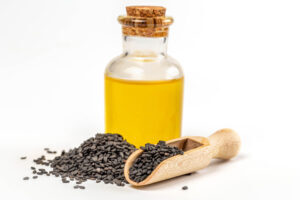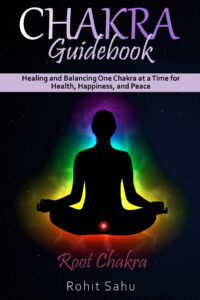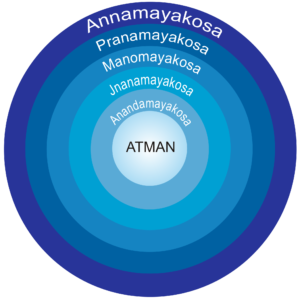Rohit Sahu's Blog, page 5
July 2, 2022
Life-Changing Habits to Practice for a Healthy You as per Ayurveda
Leading a fit and healthy lifestyle entails more than just making drastic changes and forming new habits; it also entails paying attention to your daily routine. Your daily routine and rituals have a profound influence on you, even if they are as simple as waking up, bathing, eating, and brushing your teeth! Following certain daily routines, according to Ayurveda, may help one lead a healthier life.
Ayurveda encourages preventative steps to keep your health in balance. It’s a way of life, a regular effort in our everyday routines. With the help of this ancient wisdom, we may adopt dietary and lifestyle choices that will lead to health, longevity, and realizing our greatest potential in life! Ayurveda says that you should find a balance between your body, mind, and soul because all three are connected.
After all, an imbalance in our work-life scale, as well as poor eating and drinking habits, has brought us closer to a variety of lifestyle-related ailments. It is apparent that adopting Ayurvedic lifestyle adjustments must be our go-to approach for living a happier and healthier life.
The stability of the Tridoshas is disrupted and they intensify in the body as a result of poor food and lifestyle choices. Vitiated Tridoshas disrupt the stability of Dhatus and Malas, creating vitiation that manifests as many ailments in the body. Thus, an individual’s health is determined by the stability of the Doshas, Dhatus, and Malas.
The following are some Ayurvedic Life-Changing Habits to Practice for a Healthy You:
1. Wake Up in BrahmamuhurtaAyurveda recommends that the ideal time to wake up is the Brahmamuhurta. This refers to two hours before sunrise. The reason for this is to give yourself an optimal gap, i.e., time to cleanse and nourish your body before you begin your day. Don’t worry if you haven’t gotten there yet; gradually practice getting up early and it will become a habit.
It is best to get up before sunrise since the air is cleaner at that time. The quantity of oxygen available at this hour is at its peak. The effect of early morning sun rays and a pollution-free atmosphere allows vital molecules to be produced by the body, resulting in the body remaining energized.
2. Splash Some Water on Your FaceThe first thing you should do when you get up is splash water on your face. Splashing water in the eyes is said to be an effective eye routine. Use only room temperature water that is not too hot or cold.
3. Do Oil Pulling (Before Brushing Your Teeth)Similar to tongue scraping, removing toxins and germs from the mouth contributes to the detoxification of the body. It can cure a wide range of ailments, from digestive issues to heart disease.
Consider this:
Swish 1 to 2 teaspoons of cold-pressed organic sesame or coconut oil around in your mouth vigorously like mouthwash. Spit the saponified oil out and discard it after approximately 15 to 20 minutes. During this time, you can ease your body urges or prepare your breakfast.
4. Scrape the TongueAfter oil pulling, brush your teeth, and don’t forget to scrape the tongue clean. This oral hygiene procedure has been shown to eliminate toxins from the tongue. It is more difficult to taste food if your taste buds are coated with germs and plaque. This usually results in going overboard on salt and sweets, which may contribute to overeating.
Thus, after cleaning your teeth, place the tongue scraper as far back on your tongue as you are comfortable with. Slide the scraper from the back of your tongue to the tip, using strong yet moderate pressure. Rinse and clean the scraper, then continue until no chalky residue remains. It takes 1 to 2 minutes.
5. Begin the Day with Warm WaterBeginning the day with a glass of lukewarm water is an old Ayurvedic tradition that is gaining popularity in the West. Drinking warm water elevates your body temperature, which speeds up your metabolism and helps you with proper digestion and losing excess fat.
6. Avoid Standing While Drinking WaterThis is possibly one of the most crucial healthy eating habits to develop. It is best to avoid drinking and eating while standing. Standing and drinking disrupt the body’s fluid balance, which may lead to a higher buildup of fluids in the joints, causing arthritis. Drinking water while standing also has a harmful impact on your kidneys.
7. ExerciseAyurveda suggests beginning the day with mild exercise and asanas. They aid in enhancing blood flow in the body as well as providing flexibility. You may walk, exercise, or practice yoga, but be sure that your workout uses just half of your whole body strength. If you work out more than you need to, you might get tired and weak, which defeats the purpose of working out.
Surya Namaskar, aerobics, yoga, and other forms of regular exercise build physical strength and immunity. All the body’s pathways are cleaned, blood circulation improves, and waste material is eliminated from the body. Excess fat is also eliminated.
8. Perform Pranayamas (Breathing Exercises)Deep diaphragmatic breathing expels carbon dioxide from the lungs and enhances oxygen intake, supplying your body with more vital energy. By increasing metabolism and promoting peristalsis, deep belly breathing massages your internal organs and helps digestion.
Consider this:
Kapalabhati is a breathing technique that involves pulling in your stomach muscles while exhaling forcefully. This is thought to increase the Agni, or digestive fire, and may be a good workout for your stomach.
9. Do MeditationFor a clear and focused mind that relieves mental and physical stress, meditation is a must. Research conducted at UC San Francisco separated 47 overweight women into two groups. Only one group got “mindful eating” instruction and meditated for 30 minutes every day. During the four-month study, the women who meditated lost more than a pound of belly fat and had much lower levels of the stress hormone cortisol, while the women in the control group gained weight.
Meditation may range from simple breath awareness to moving meditation or yoga. Choose the ones that speak to you and stick to them. The more practice you put in, the simpler it will become. In the advanced stages of meditation, you can seek higher spiritual goals as well.
10. Perform AbhyangaFollowing yoga and meditation, the body cleansing process begins. Ayurveda stresses body oiling since no moisturizer can substitute it. If you don’t have time to massage yourself every day, try to do it at least three times a week in the winter and twice a week in the summer.
It is necessary to massage the whole body, but if you are short on time, you should massage these five body regions at the very least. These are the naval, the soles of the feet, the head, the ears, the hands, and the elbows.
Oiling should preferably be done before having a bath, and you may use any oil for this procedure, including olive oil, coconut oil, mustard oil, and sesame oil. It makes the skin healthy and beautiful. It improves cutaneous blood circulation. Toxic compounds are expelled from the body via perspiration, and the skin becomes wrinkle-free.
11. Perform NasyaPutting 2-3 drops of warm and then cooled mustard or sesame oil in the nostrils every morning protects against the head, eye, and nose infections. Your vision improves, and your hair becomes long, thick, and black. It helps to prevent premature hair loss and graying. After Nasya, you should take a soothing bath.
12. Drink Ginger Tea and Warm WaterCold water might really impair your digestion. Drink plenty of warm water and ginger tea throughout the day and with meals instead. Ginger tea also aids digestion by increasing Agni (digestive heat).
Consider this:
Begin with one cup of ginger tea in the morning and gradually increase your consumption to two to four cups each day.
The most crucial part of keeping the body healthy is the food. As a result, the next points will be on food and eating habits.
13. Incorporate the Six “Tastes” into Every MealAyurveda considers the six flavors to be sweet, sour, salty, bitter, pungent, and astringent. Every fruit, vegetable, grain, nut, and legume has a distinct “flavor,” or a mixture of several. In an ideal world, you would include them in every meal.
Consider this:
Keep it easy and sprinkle an Ayurvedic spice mix with tastes like coriander, ginger, mustard, turmeric, cinnamon, and cayenne pepper over your meals. It also helps to choose whole foods and to make sure your meals have a rainbow of colors.
14. Avoid Eating If You are Feeling Very EmotionalWhen you’re occupied with strong emotions, chances are you’re not paying attention to what you’re eating. This may cause poor dietary choices, overeating, poor digestion, and meal dissatisfaction. Before taking up your fork, wait for the storm to pass.
Breathe deeply and visualize letting the sensations fade with each breath. Repeat until you feel calm and in control. After that, eat something.
15. Take Your Time When EatingThe digestive process begins with chewing, thus chew your meal thoroughly. Your salivary glands create digestive enzymes when you chew, which aid in the breakdown of your meal. This allows for improved food digestion and allows the digestive enzymes in your mouth to perform their job effectively. Also, chewing for a longer amount of time also allows your stomach more time to indicate your brain that you’re full, keeping you from overeating. If your meal is not digested properly, it may cause a slew of digestive issues, gastrointestinal troubles, and even weight gain.
Try this: Before swallowing, chew your meal until it is as mushy as possible. Instead of rushing through your meal, take your time.
16. Eat in SilenceDon’t get me wrong; there’s nothing like enjoying a delicious lunch with friends and family. But try eating in silence every now and then. When you do this, you enjoy your food more and can hear your body’s signal that you’re full, which helps avoid overeating and leaves you feeling more satisfied after your meal.
Consider this:
With mindful eating, concentrate on the aromas of your meal and zoom in on the sensations and tastes. Take your time, be grateful for what nature has to offer, and savor every bite.
17. Eat Seasonally Appropriate FoodsAlways pick foods according to the season. It is a common piece of advice, and it’s a terrific healthy eating habit to instill in your life.
Foods like Gud (jaggery) and ghee are naturally warm, so they are best taken in the winter. Curd, on the other hand, has a cooling effect. If consumed throughout the winter, they may worsen a cold by producing mucus in the throat. Consume seasonal fruits at all times. Good eating habits are essential for maintaining a healthy mind and body.
18. Do Not Overeat or Eat Right After a Full MealYou must know where to stop and never eat without real hunger. Try to eat light Sattvik foods. Seasonal foods, fruits, vegetables, dairy products, nuts, seeds, oils, and ripe vegetables are prioritized in the Sattvik diet. Eating Sattvik food regularly helps to detoxify your body of the toxins accumulated by pollution in the environment and junk food consumed outdoors. Healthy eating habits may help you feel physically and mentally active.
19. No Distracted EatingAvoid eating while watching television, talking on the phone, or reading the newspaper. According to Ayurveda, you are alive because you have food on your plate; therefore, it should be treated with the highest care. Distracting surroundings impair your body’s capacity to digest what you’ve consumed.
20. Eat Your Meals Sitting DownEat your meals sitting down at all times. Distracted eating is frowned upon in Ayurveda; one must chew their meal thoroughly. Put all of your worries and commitments aside and consume the meal. Sitting down keeps you from being distracted and directs your focus to what is on the plate. Several specialists have also suggested that while sitting and eating, your posture is excellent for easy digestion and the prevention of gastrointestinal disorders. Also, eating in a suitable sit-down setting shows respect for the food. The concept of “Sukoon” is also highly essential in Ayurvedic dietary practice. “Sukoon” basically translates to pleasure, contentment, and fulfillment, all of which may be attained while sitting and eating.
21. Do Not Pair Foods CarelesslyAccording to Ayurveda, certain food combinations disturb the normal functioning of the gastric fire, upset the balance of the doshas, and lead to problems like indigestion, fermentation, putrefaction, and gas formation. Some of the incompatible combinations are milk-banana, yogurt and sour fruits, eggs-milk, and honey-ghee.
22. Sleep WellExcept in the summer, 6–8 hours of sleep is required at night in all seasons. In the summer, one should rest for 1-2 hours during the day and at night since the heat causes the body to lose water and energy. A nap during the day replenishes this. Physical and mental tiredness is relieved by getting enough sleep, and digestion is enhanced, injecting fresh vitality into the body.
Do You Know Some More Life-Changing Habits I Missed? Let Me Know in the Comments Below. Hope These Habits Transform Your Health Physically, Mentally, and Spiritually…
The post Life-Changing Habits to Practice for a Healthy You as per Ayurveda appeared first on Ayurveda & Spirituality with Rohit.
June 17, 2022
Your Manipura/Solar Plexus Chakra Healing Guide
There’s been a lot of talks lately about chakras, chakra healing, and chakra balancing. But, before we get into how to balance the chakras, we need to first understand what they are, what they symbolize, and how they affect our mind, body, and life. This introduction covers it all!
The chakras are a component of the subtle body, also known as the energy body. It is the portion of the body that we cannot see or touch yet can always feel. It is the part of us that beats our hearts, the part of us that has gut instincts, and the energy inside us that connects, moves, and defines our being.
The seven chakras are the body’s primary energy centers. Unblocking or healing our chakras refers to the idea that when all of our chakras are open, energy can flow freely through them and there is harmony between the body, mind, and soul.
Each chakra emits a distinct color and energy, and each corresponds to a gland in the physical body. Because each chakra is associated with unique spiritual, emotional, psychological, and physical parts of our being, their blocking or dysfunction might cause physical, psychological, and emotional problems. Conscious awareness and balance of these energy centers, on the other hand, are said to result in happiness and good health.
The concept of chakras was initially conceived thousands of years ago in ancient India, and the oldest evidence of chakras may be found in the Vedas. They are the earliest known texts of Hinduism and the oldest known written Sanskrit, dating back to 1500–500 BCE. The Upanishads (part of the Vedas) include evidence of chakra theories, which influenced the spirituality of Hinduism, Buddhism, and other ancient eastern faiths.
After we’ve evolved beyond the physical-emotional necessities of survival and self-preservation of the first chakra, Muladhara, the second chakra is where Prana is awakened and we begin to experience the world consciously. The Root Chakra is an unconscious state of being, while the Sacral Chakra allows us to become aware of our surroundings. The Manipura/Solar Plexus Chakra is the seat of your ego as well as the source of your energy and will. It is in charge of your life choices, which mirror the directions in which your energy flows.
This chakra is the foundation of your personality and sense of self. When balanced, it allows authenticity to blossom and enables your True Self to shine forth. It allows you to face your fears, manage your thoughts, and make conscious decisions.
This chakra also oversees the digestive system and its organs. Because the fire element is associated with the Solar Plexus Chakra, it plays an important function in digestion. And it is a center for not just physical but also the metaphorical digestion of thoughts, emotions, and events in our life. Furthermore, it is linked to one of life’s most important concerns: our feeling of purpose.
Solar Plexus Chakra AttributesSanskrit Name: Manipura (“City of Jewels”; sometimes translated as “Lustrous Gem”).
Meaning: The Solar Plexus Chakra is the vitality center. It regulates our energy balance to maintain and enhance our health. This Chakra attracts Prana from the Cosmos, much like a magnet. This chakra governs the function of the pancreas and digestive organs as the seat of digestive fire.
Location: It is located in the upper abdomen, two inches above the navel.
Element: Fire is the element linked with the Solar Plexus Chakra. It is a symbol of the Sun’s energy. Fire handles your inner strength, vigor, ego, willpower, endurance, and inner power. From it comes your drive to get things done and maintain your sense of self.
Qualities: Personal strength, knowledge, and understanding. It aids in the development of a strong sense of self, the establishment of personal boundaries, and the development of self-esteem and willpower. This chakra gives you the power to influence your life and the world around you.
Color: Yellow. It is fiery, just like the sun. It exhibits confidence, reliability, responsibility, purposefulness, and motivation.
Color Psychology: Yellow is the color associated with the Manipura Chakra. This color represents vitality, intelligence, and a person’s relationship with the Sun and Fire. Yellow is often associated with youth, fresh beginnings, birth, and rebirth. Yellow is also associated with intelligence and wisdom. The color attracts those who are engaged in intellectual pursuits.
Sensory: Eyesight (Perception)
Endocrine Gland: The pancreas and the outer adrenal glands, the adrenal cortex.
Organs: Stomach, intestines, gallbladder, liver, pancreas, and spleen.
Developmental Stage: It forms when we are between the ages of 15–21 and gains an understanding of who we really are, what we really want, and what our purpose is.
Balanced/Flowing Energy: A person with a balanced Solar Plexus Chakra emanates confidence (without being arrogant), is self-motivated, and has a feeling of purpose. It gives you judgment clarity, self-assurance, confidence, self-discipline, and independence.
Imbalanced: When the Solar Plexus Chakra is imbalanced, you may feel low self-esteem, lack of self-trust, and a weak will. You can suffer from sadness, have difficulty making decisions, and may have anger or control issues.
Psychological Symptoms of Blockage: Excessive fire and energy in the Solar Plexus Chakra may cause impulsive responses like anger and violence, which are signs of a blocked chakra. Some more psychological symptoms include doubt and mistrust of others, as well as a great deal of anxiety about what others may think of you. Some individuals may struggle with poor self-esteem and want constant validation and praise from others. This imbalance may cause you to form unhealthy bonds with the people in your life.
Physical Symptoms of Blockage: You might feel bloated and nauseous and may also experience cramping. It might also seem like you are struggling to remember things. You can also experience ulcers or heartburn when this chakra is blocked. Problems with the pancreas, diabetes, stress-related illnesses, blood pressure issues, and digestive problems to do with the ‘digestive fire’ or Agni are some more signs.
Mantra Seed: RAM
Benefits of Solar Plexus Chakra BalancingThe specific benefits of balancing the Solar Plexus Chakra will vary depending on where you are in the healing process. Regardless of where you’re starting from, completing inner work may help you balance your chakra or chakras. The Solar Plexus is your energy hub, radiating vital prana, which is the complete quantity of energy manifested in this universe throughout your entire body.
People with a healthy Solar Plexus Chakra are impulsive and uninhibited, with great personal strength and high regard for themselves and others. These individuals possess a high level of self-confidence and self-esteem. Here you will find the archetype of the spiritual warrior with a purpose and the courage and conviction to be.
The Solar Plexus Chakra symbolizes our feelings of self-worth, personal power, mental strength, and spiritual development. We feel weak and unworthy when this chakra is out of balance. As a result, a balanced Solar Plexus Chakra will help you reclaim your sense of core and wholeness. You’ll unlock your latent potential and embrace and recognize the viewpoints and opinions of others. You’ll be working on your spiritual growth as well.
The following are the most significant benefits of a healthy Solar Plexus Chakra:
DeterminationSelf-confidenceSelf-esteemPositive thinkingA balanced approach to emotion managementSetting boundariesMaintaining positive social interactionsDecision-making skills with courage and determinationIntellectual skillsEvolving constantly forward in one’s chosen route with determinationSymptoms of Solar Plexus Chakra BlockageWhen the Solar Plexus Chakra is unbalanced you may feel:
Low self-esteemLack of self-trustWeak willPoor digestionVictim mentalityUnable to take responsibilityAttraction to stimulantsNot feeling good enoughWhen the solar plexus chakra is underactive you may feel:
Eating, intestinal, or digestive disordersHypoglycemiaDiabetesEczema/acneFood allergiesChronic fatigueDepressionWhen the solar plexus chakra is overactive you may feel:
Overly aggressiveNeed to be rightBossyPower hungryCompetitiveAttraction to sedativesConceitedSelf-centeredSolar Plexus Chakra BalancingWe lack confidence, stamina, motivation, and direction when Manipura is out of balance. An overactive Manipura Chakra, on the other hand, manifests as aggressive behavior, rage, and a need for sedatives.
But the good news is that we can boost the functioning of our chakras, both mentally and physically. We can control how energy moves through these regions, which is good for our overall well-being. Chakra balancing and alignment is a frequent, and sometimes daily, activity to explore. But how can one bring the Solar Plexus Chakra back into balance?
Problems with the Solar Plexus Chakra may be addressed by taking a break from your daily chores and understanding the hurdles in your life. Yoga, pranayamas, visualization, mantras, meditation, aromatherapy, and other similar practices may help to maintain the vitality of your Solar Plexus Chakra.
Symptoms Your Solar Plexus Chakra is OpeningThese are the most common signs that your Solar Plexus Chakra is opening:
1. Increase in Self-Confidence
The Solar Plexus Chakra has a significant impact on your ego, self-perception, and self-confidence. A sign of your Solar Plexus Chakra opening is that you will naturally and effortlessly become more confident. As your Solar Plexus Chakra opens, you will naturally exude charm.
2. You Start to Live in the Present
When your Solar Plexus is open and active, you will be more at peace with yourself and the flow of life.
It is much simpler and more natural to live with your attention in the present moment when you are in this state of empowered ease. You may let go of past regrets and future worries and truly appreciate the pleasure of being you in the Now. Thus, if you notice you are more immersed in the present moment and flowing with life, this might be a sign that your Solar Plexus Chakra is opening.
3. Your Interpersonal Relationships will Improve
Comfort, inner delight, real connection, and satisfaction in your relationships may all be signs of your Solar Plexus Chakra opening.
When your Solar Plexus Chakra is awakened and aligned, you realize your actual strength, self-worth, motivation, and physical and energetic wellness. These improvements and alignments in your connection with yourself will show up in all of your relationships; your connections with your spouse, family, and friends, as well as the entire world around you.
4. You Gain Clarity and Passion About Your Life’s Purpose
Another sign that your Solar Plexus Chakra is opening is that you will get clarity about your life’s purpose and feel more connected with it. You may be able to view your life in a new way where everything makes more sense. You will understand how your life path has brought you to this point in time and the aspects of your life’s purpose more clearly.
The Solar Plexus Chakra governs willpower and the capacity to act in an inspired and aligned manner. When you feel inspired to concentrate on and appreciate behaviors that are in harmony with your life purpose and ambitions, this might be an indication that your Solar Plexus Chakra is opening.
5. You Can Feel Greater and More Genuine Self-Acceptance and Love
Your ability to put your goals and needs in the right order is another sign that your Solar Plexus is opening. Your relationship with yourself will get better, and you may feel more and more love and acceptance for yourself.
ConclusionThe Solar Plexus Chakra promotes self-assurance and vigor. This allows you to pursue your genuine calling and live the life you choose. The Solar Plexus Chakra, when balanced, helps you to claim your inner power, discover your True Self, and take charge of your life.
Manipura is the chakra that calls us to develop our one being, one will, and one identity. It is here that we learn how to unite all of our internal energy into one powerful and persistent self, which then acts as the basis for all upper chakra activity and the governor of the two lower chakras.
Any successful individual in the world may be attributed to their persistent and fierce Solar Plexus Chakra. Identifying and implementing the mentioned methods can assist you in balancing it, which promotes success and longevity.
To Learn More In Depth About Solar Plexus Chakra Healing and Balancing, Check This Out:In this book, you’ll discover: A Basic Introduction to Chakras
A Basic Introduction to Chakras Common Chakras Myths
Common Chakras Myths Importance of Solar Plexus Chakra in Your Body
Importance of Solar Plexus Chakra in Your Body Significance of Solar Plexus Chakra Balancing
Significance of Solar Plexus Chakra Balancing Blocked Solar Plexus Chakra Symptoms
Blocked Solar Plexus Chakra Symptoms What Causes Solar Plexus Chakra Blockage?
What Causes Solar Plexus Chakra Blockage? Solar Plexus Chakra Balancing Techniques (Visualization, Pranayamas/Breathwork, Affirmations, Mantras, Aromatherapy, Crystals, Yoga, Reiki, Food, Herbs, Sound Therapy, Meditation, and more)
Solar Plexus Chakra Balancing Techniques (Visualization, Pranayamas/Breathwork, Affirmations, Mantras, Aromatherapy, Crystals, Yoga, Reiki, Food, Herbs, Sound Therapy, Meditation, and more) Symptoms Your Solar Plexus Chakra is Opening
Symptoms Your Solar Plexus Chakra is Opening And Much More
And Much More
This book is packed with all the information, tips, and techniques that will make sure that you can effectively heal, balance, and open your Solar Plexus Chakra.
The post Your Manipura/Solar Plexus Chakra Healing Guide appeared first on Ayurveda & Spirituality with Rohit.
June 3, 2022
Your Sacral Chakra/Svadhisthana Healing Guide
There’s been a lot of talks lately about chakras, chakra healing, and chakra balancing. But, before we get into how to balance the chakras, we need to first understand what they are, what they symbolize, and how they affect our mind, body, and life. This introduction covers it all!
The chakras are a component of the subtle body, also known as the energy body. It is the portion of the body that we cannot see or touch yet can always feel. It is the part of us that beats our hearts, the part of us that has gut instincts, and the energy inside us that connects, moves, and defines our being.
The seven chakras are the body’s primary energy centers. Unblocking or healing our chakras refers to the idea that when all of our chakras are open, energy can flow freely through them and there is harmony between the body, mind, and soul.
Each chakra emits a distinct color and energy, and each corresponds to a gland in the physical body. Because each chakra is associated with unique spiritual, emotional, psychological, and physical parts of our being, their blocking or dysfunction might cause physical, psychological, and emotional problems. Conscious awareness and balance of these energy centers, on the other hand, are said to result in happiness and good health.
The concept of chakras was initially conceived thousands of years ago in ancient India, and the oldest evidence of chakras may be found in the Vedas. They are the earliest known texts of Hinduism and the oldest known written Sanskrit, dating back to 1500–500 BCE. The Upanishads (part of the Vedas) include evidence of chakra theories, which influenced the spirituality of Hinduism, Buddhism, and other ancient eastern faiths.
After we’ve evolved beyond the physical-emotional necessities of survival and self-preservation of the first chakra, Muladhara, the second chakra is where Prana is awakened and we begin to experience the world consciously. The Muladhara is an unconscious state of being, while the second chakra allows us to become aware of our surroundings.
Because of its connection to reproductive systems and processes, relationships, emotions, and a feeling of adventure, the Sacral Chakra, or Svadhishthana in Sanskrit, has been nicknamed “The Sex Chakra,” “The Social Chakra,” and “The Creation Chakra.” This chakra is linked to all the experiences and karmas that we have as conscious beings on this Earth.
It is located below the navel, in the pelvic region, near the perineum. The bladder, kidneys, and reproductive organs are located in this part of the body, just above the seat of our Root Chakra. In this way, the Sacral Chakra is linked to the ovaries in females and the testicles in males. All the pelvic floor muscles are considered part of the Root Chakra and Sacral Chakra combined.
Sacral Chakra AttributesSanskrit Name: Svadhishthana (sweetness, “my own sweet abode”).
Meaning: This chakra handles your sexual and creative energy. It’s also linked to how you relate to your emotions and the emotions of others.
Location: The Sacral Chakra is located 2.5 to 5 cm (one to two inches) below the naval.
Element: It’s associated with the water element and portrayed as vibrant orange color. The Sacral Chakra governs the water element inside of you, all that is fluid. This energy center relates to fun, freedom, creativity, flexibility, sex, pleasure, and money. Some people say it is the seat of our emotions, and in my experience, that is true—for others, it’s the heart.
Qualities: Flexibility and adaptability.
Color: Orange. Specific chakra color frequencies correspond to our varied mental states and emotions. Orange has a denser frequency.
Color Psychology: The color orange represents activity, purity, and increasing consciousness and lust. Being the center of passion, the Svadhishthana begets the power to create and control desires and needs. Therefore, the Svadhishthana is associated with the orange color. Also, the Sacral Chakra is described as possessing feminine energy and is linked to the water element with a pictorial representation of a flower and a crescent moon.
Sensory: Tongue (Taste).
Endocrine Gland: Adrenal cortex/adrenal glands (fight-flight).
Organs: Heart, brain, and reproductive organs.
Developmental Stage: It forms when we are between the ages of 8 and 14 and just beginning to develop a sense of self.
Balanced/Flowing Energy: When this chakra is balanced and functioning properly, we can expect our relationship with ourselves and the world to be harmonious, pleasureful, and nurturing.
Imbalanced: When the Sacral Chakra is imbalanced, it can make you feel emotionally and physically weak.
Psychological Symptoms of Blockage: When the second chakra is blocked, telltale emotions that may flood the system include lacking self-worth, feeling unworthy, shame, and jealousy. Shame is one of the main emotions related to Sacral Chakra imbalances. Other emotions that may circulate are social anxiety, rigidity, and judgment. Those with a Sacral Chakra blockage may find it hard to go with the flow or express themselves emotionally. Negativity and a lack of joy in life are also linked to sacral blockages, as well as self-criticism, lack of creativity, fear of the unknown, and extreme shyness, which are all symptoms of a blocked Sacral Chakra.
Physical Symptoms of Blockage: Physical symptoms such as anemia, hypoglycemia, lower back pain, joint problems, low energy, spleen and kidney issues, and premenstrual syndrome can result from an imbalance in the Sacral Chakra.
Mantra Seed: VAM
Benefits of Sacral Chakra BalancingThe flow of energy and vitality through our bodies might be helped by a balanced Sacral Chakra. It has the potential to empower us to love unconditionally, be non-judgmental, and live fully. It helps to keep the flow of creative energy flowing smoothly. This chakra’s ideal balance may help us feel more committed, pleasurable, and sensuous.
When this chakra is perfectly balanced, you are courageous by nature. You have a trusting attitude and are creative. You have a great understanding of your sexuality and see it as one of your most potent creative forces. In our non-intimate relationships, it allows us to show our True Self, pursue our dreams, and serve others without attachment to results.
When this chakra is well-nurtured, we can differentiate ourselves from the tribe that raised us. We accept and embrace our True Self and listen to our individuality to live out our dreams. You’ll feel active, energized, and full of ideas. This chakra is also aligned in a way that gives you the confidence to make big changes in your life. On the other hand, anything that is monotonous or suffocating might push your Sacral Chakra out of balance or block it. As a result, your Sacral Chakra may be hurt if people don’t like your creativity or sexuality.
Symptoms of Sacral Chakra BlockagePhysical:
ConstipationBack painUrinary and kidney infectionsGynecological cystsInfertilityImpotencePain in the lower backPain in the sacrumPain in the hips and/or legsMenstrual problemsMenopause symptomsPain in groin and pelvisFatigueBladder discomfortReduced libidoIncreased allergic symptomsMore frequent urination
Mental, Emotional, and Psychological:
DepressionLow self-esteemInsecurityDetachmentJealousyFearAn inability to find what you need to feel at home in lifeOvereatingPoor hygieneOverspendingLack of healthy boundariesInability to feel pleasure or joyEmotional outbursts or withdrawalSex being exploited for material gainInability to engage in intimacyWorkaholic tendenciesDesire to numb feelingsLack of self-worth and confidenceDeliberate risk-takingLack of purposeCrisis-oriented behaviorDisconnection from societyIsolation and detachment from societyFeelings of lethargy, lack of creativity, or feelings of being ‘stuck’Feeling easily offendedLack of creative inspirationFear of changeGuilt about the pastAddictive behaviors (such as the use of drugs or alcohol, excessive spending, overeating, gambling, and conflicted sexual desires/sexual compulsion)Sacral Chakra BalancingWhen the Sacral Chakra is out of balance, you may experience emotional and physical weakness. Depression, hypersensitivity, and anxiety are all symptoms of a disrupted energy system. An imbalanced Sacral Chakra manifests as a fear of losing control in a relationship with compulsive or obsessive conduct. It also affects one’s relationship with tangible objects, such as employment and profession.
The good news is that you can cease these imbalances in the body, mind, and soul and balance the Sacral Chakra with certain habits. You can source energy for creativity, movement, procreation, desire, pleasure, and relationships when the Sacral Chakra is in fine condition. In relationships, you will be able to openly express your desires and requirements. When your sacral is aligned, it will be easier for you to tap into your creativity and visualization.
You should sense a difference in your connections with people, meals, spirituality, animals, and nature once your Sacral Chakra is balanced. You may also experience increased intuition, emotional control, creativity, and sexual intimacy.
People who have their Sacral Chakras balanced are at ease giving and receiving pleasure, love, money, and material goods. They have a feeling of internal balance between their masculine and feminine aspects and know when and how to say no.
When your Sacral Chakra is clear, powerful, and harmonious, you will feel at ease in your own skin. You’ll no longer suffer from sexual guilt or indulgence, but you’ll learn to respect and appreciate your holy sexuality healthily. You’ll not only appreciate life’s joys, but you’ll also be open and enthusiastic about experiencing life. You’ll be emotionally accessible while still being grounded and maintaining appropriate limits. Also, your creative flow will come back and you’ll be able to enjoy life’s surprises again.
Balancing the Sacral Chakra may be accomplished in a variety of ways. It involves time and patience, as well as self-love. Yoga, Reiki healing, daily affirmations, healing stones or crystals, and many other techniques are among them. If you use these Sacral Chakra healing practices daily, you will notice a significant change in your health.
Symptoms Your Sacral Chakra is OpeningThese are the most common signs that your Sacral Chakra is opening:
1. You Accept Yourself Exactly as You are
A common sign that your Sacral Chakra is opening is that you will feel more at ease and connected to your physical body. Turning against oneself is one of the worst effects of Sacral Chakra imbalance. You become your own worst critic. Restoring chakra balance restores your trust in yourself.
When this chakra opens, you will feel more at ease in your own skin, more connected to your physical health, mobility, and sensory experiences. You’ll be more concerned with feeding and preserving your valuable physical body. You won’t be miserable or uncomfortable in your skin anymore.
When your Sacral Chakra is open, you become more aware of the possibility of pleasure, happiness, and a wide range of life experiences that having a body provides. With the critic in you gone, you conclude that your body isn’t that horrible after all. The better you get, the more good aspects of your body you find. Your nose may be imperfect, but you have great hair and hands. You also understand that no one is perfect.
2. You Put a High Priority on Self-Love and Self-Care
Genuine self-love and self-care are the foundations of the energy you offer to every relationship or experience, and these emanate from our Sacral Chakra.
When you value embodiment and consciousness in your connection and respect for yourself, your life experience is naturally channeled with the knowledge of self-love and self-care, which is a Sacral Chakra opening symptom. You will realize the value and need for self-love and self-care when this chakra is balanced and open.
3. You Have a Better Understanding of Your Aspirations
If you feel fuzzy and confused, it’s because your Sacral Chakra is out of balance. As life regains its vitality, you have a better idea of what you want. You learn to differentiate between actual needs and fleeting whims. You recognize your value and realize that you’re deserving of good things.
4. Your Relationships Improve
Certain relationships either drift away because they are no longer aligned or improve dramatically when you are comfortable, happy, and loving. This is because you’ve broadened your horizons and approached life with the awareness of an open Sacral Chakra. This enables you to have a better understanding of masculine and feminine energy as creative energies and inherent dualism in both our inner and outer relationships.
You will notice and better care for your existing relationships as well as attract powerful relationships that offer you joy, connection, and co-creation as a Sacral Chakra opening symptom. You’ll begin to focus more on appropriate connections. This entails strengthening the link and progressing to the next step. You come to appreciate your partner’s companionship more than ever before. You have a greater understanding of each other and get along well. Life is once again magnificent.
5. You Have a Stronger Desire to Express Yourself Creatively
We may be fascinated by diverse methods of expressing ourselves artistically while this chakra is opening. You could discover that expressive mediums like painting, music, dance, invention, poetry, and creative writing spark your curiosity. You’ll find yourself drawn to creativity, enjoying imagination, and engaging more actively in creative experiments and projects. You find out how to use your imagination.
When your Sacral Chakra is working at its best, you discover your creative skills and focus on them to develop your expertise. You discover you have a gift for music, painting, creative writing, dancing, or anything else. You’re having fun with your artistic endeavors.
6. You are More Conscious of and Accepting of Your Desires
The Sacral Chakra is the pleasure and joy center. What offers you pleasure and happiness may be specific to you and your life goals. An open and functioning Sacral Chakra allows you to connect with your deepest desires and may help you realize them. You may become clearer about your aspirations, self-acceptance, and the deep awareness that you are worthy of.
7. You Learn to Appreciate and Respect the Process
Another sign that your Sacral Chakra is opening is that you will start to respect and even enjoy the processes and cycles that happen in your life. You learn to trust the Universe more and to stop rejecting life’s adjustments. You recognize that wonderful things will come to you if you are truthful and honest. This awareness will aid in your relaxation and acceptance of life.
You’ll have a better grasp of the nature of creative energy, how death may lead to rebirth, how incubation periods can lead to inspiration, and how both masculine and feminine aspects are equally important in creation. Having a natural understanding of how the Sacral Chakra opens can help us understand and connect with how creative energy moves, which helps us to be more present and trust the process.
ConclusionWhen the Sacral Chakra is healthy and balanced, life becomes more harmonious and peaceful. With each new experience that life provides, you will express yourself artistically and grow up. You will be able to accept both positive and negative events.
Self-inquiry may aid in the healing and restoration of the Sacral Chakra. By knowing your emotions and reactions, you may better neutralize the unconscious programming that governs your behavior. This will let you choose your reaction. Rather than a system of rules that dominates you, you will see your emotions as useful signs.
Remember that you are a lovely creature, and that life is a wonderful adventure. Take some time to play and have fun so that life becomes easier and more enjoyable, and a balanced Sacral Chakra encourages you to do just that.
To Learn More In Depth About Sacral Chakra Healing and Balancing, Check This Out:In this book, you’ll discover: A Basic Introduction to Chakras
A Basic Introduction to Chakras Common Chakras Myths
Common Chakras Myths Importance of Sacral Chakra in Your Body
Importance of Sacral Chakra in Your Body Significance of Sacral Chakra Balancing
Significance of Sacral Chakra Balancing Blocked Sacral Chakra Symptoms
Blocked Sacral Chakra Symptoms What Causes Sacral Chakra Blockage?
What Causes Sacral Chakra Blockage? Sacral Chakra Balancing Techniques (Visualization, Pranayamas/Breathwork, Affirmations, Mantras, Aromatherapy, Crystals, Yoga, Reiki, Food, Herbs, Sound Therapy, Meditation, and more)
Sacral Chakra Balancing Techniques (Visualization, Pranayamas/Breathwork, Affirmations, Mantras, Aromatherapy, Crystals, Yoga, Reiki, Food, Herbs, Sound Therapy, Meditation, and more) Symptoms Your Sacral Chakra is Opening
Symptoms Your Sacral Chakra is Opening And Much More
And Much More
This book is packed with all the information, tips, and techniques that will make sure that you can effectively heal, balance, and open your Sacral Chakra.
The post Your Sacral Chakra/Svadhisthana Healing Guide appeared first on Ayurveda & Spirituality with Rohit.
May 13, 2022
Your Root Chakra/Muladhara Healing Guide
There’s been a lot of talks lately about chakras, chakra healing, and chakra balancing. But, before we get into how to balance the chakras, we need to first understand what they are, what they symbolize, and how they affect our mind, body, and life. This introduction covers it all!
The chakras are a component of the subtle body, also known as the energy body. It is the portion of the body that we cannot see or touch yet can always feel. It is the part of us that beats our hearts, the part of us that has gut instincts, and the energy inside us that connects, moves, and defines our being.
The seven chakras are the body’s primary energy centers. Unblocking or healing our chakras refers to the idea that when all of our chakras are open, energy can flow freely through them and there is harmony between the body, mind, and soul.
Each chakra emits a distinct color and energy, and each corresponds to a gland in the physical body. Because each chakra is associated with unique spiritual, emotional, psychological, and physical parts of our being, their blocking or dysfunction might cause physical, psychological, and emotional problems. Conscious awareness and balance of these energy centers, on the other hand, are said to result in happiness and good health.
The concept of chakras was initially conceived thousands of years ago in ancient India, and the oldest evidence of chakras may be found in the Vedas. They are the earliest known texts of Hinduism and the oldest known written Sanskrit, dating back to 1500–500 BCE. The Upanishads (part of the Vedas) include evidence of chakra theories, which influenced the spirituality of Hinduism, Buddhism, and other ancient eastern faiths.
The Root Chakra, also known as the Muladhara Chakra, is the 1st wheel of energy and is located at the base of the spine. This chakra is connected to the Earth element and is directly related to the roots we’ve established—how deep, powerful, and supporting they are. The Muladhara Chakra represents essential problems such as shelter, safety, security, water, food, and family.
We feel anchored, secure, and safe when this chakra is balanced. Our lives flow elegantly, with a constant and consistent vitality. Life is tough when it is out of harmony. We become anxious and afraid, and our survival mode kicks in. Weight gain, constipation, tiredness, melancholy, anxiety, and stress may all result from this.
The Root Chakra is the foundation of our life force energy and serves as a connection between the outer physical world and our inner energetic system—it motivates us to wake up each day, eat, and procreate. It is the hub for cultivating self-esteem, integrity, and a feeling of belonging. The spinal cord develops from the bottom up in the womb, beginning with the Root Chakra and progressing to the Crown Chakra.
Muladhara is made up of two Sanskrit words: Mula, which means “Root,” and Adhara, which means “Support” or “Base.” It is tied to your capacity to dig in and feel securely planted in your life and is associated with the Earth element.
Root Chakra AttributesSanskrit Name: Muladhara (root support).
Meaning: It determines your ability to feel calm, safe, grounded, and secure. It’s also where you’re able to pull in energy and money and manifest your desires.
Location: Coccyx, the first three vertebrae at the base of the spine.
Element: Earth. Earth is our mother, and our bodies are made up of her components. She gives us strength and nourishment.
Qualities: Enthusiasm or inertia.
Color: Red. Specific chakra color frequencies correspond to our varied mental states and emotions. Red has a dense frequency.
Color Psychology: Red is a very physical color. It promotes a feeling of being grounded and connected to the Earth. This color brings to mind thoughts and feelings of survival and instinct. Red can make you feel alert, vigilant, and primal. The survival issues connected here to this color may include things like money, financial independence, and basic things like food. Therefore, it represents the human beings’ foundation and the crucial feelings in the life of being grounded. Other people associate the Root Chakra with courage, power, strength, love, war, and desire.
Sensory: Primary smell (olfaction)
Endocrine Gland: Adrenal cortex/adrenal glands (fight-flight).
Organs: Bladder, colon/large intestine, skeleton, foot, leg, teeth, and arterial blood flow to the left chamber of the heart.
Developmental Stage: From the womb to 12 months.
Balanced/Flowing Energy: When this chakra is open/energy is flowing, we feel secure, at home in the world, and unafraid.
Imbalanced: Fear and different sorts of trauma obstruct the Root Chakra. Lethargic, with an eating disorder.
Psychological Symptoms of Blockage: Anxiety disorders, fear, panic attacks, anxiety, overthinking, melancholy, nightmares, being emotionally distant, separated from the body, anger/rage.
Physical Symptoms of Blockage: Lethargy and exhaustion, difficulties with the colon, bladder, elimination, or troubles with the lower back, left arm, leg, or foot, inflammation and cramping prostate issues may arise in males. Eating problems may also indicate a Root Chakra imbalance.
Mantra Seed: LAM
Benefits of Root Chakra BalancingSome benefits of Root Chakra balancing are:
Peak Health: You are no longer plagued by illnesses and other issues like gas, hypertension, anxiety, headaches, mood swings, and so on.Calm and Active Mind: As you become older, your mind does not slow down, but by meditating on chakras every day, your mind will get younger by the day.Strength: It is the feeling of being constantly pumped up as if you were at a gym. This occurs when you connect with your Muladhara Chakra, which is the seat of mother Kundalini. This isn’t a hypothesis; it’s a fact.Balance: When we speak about balance, we don’t mean sanity; we mean finding that perch between sanity and insanity from which you might travel and adventure. Madness is an adventure. It is a good thing to have as long as you have control over it. It will become nasty if you lose control. Similarly, sanity is a lovely thing, but if you become completely sane, you are as good as dead. This ability to venture and adventure into whatever you want at any moment will come to you if your Muladhara is balanced.Understanding: Balancing the Root Chakra seems to open up a fresh stream of knowledge that you know does not come from your intellect. Sometimes you have answers to questions you’ve never heard of before. The answers just rush through your mind, answers you’ve never known before. It’s astounding!Symptoms of Root Chakra BlockagePhysical:
Problems with the BladderConstipationLower backacheEating disordersKidney stonesLeg sluggishnessStiffness and pain in your feet and legsExcessive hamstring flexibility or lack of muscular stabilityMental:
RestlessnessInsecurityExcessive rage and aggressivenessImpatienceGreedinessObsession with material thingsEmotional:
Cravings for fatty, comfort mealsImpression that your parents have abandoned youFeeling like you’re not good enough as you areFeeling cut off from the rest of the worldFeeling distant from family or wanting to be distant from relationsPlaying a spacey characterBeing a homebody as a result of idleness or melancholyHaving difficulty defining bordersHaving difficulty with self-disciplineFeeling abnormally downFeeling passiveHaving a greater dread of changeHaving frequent paranoid thoughtsLife, love, and career are all being questionedFeeling aggressiveExhibiting dominating behaviorLifestyle:
Life at home is hectic and unsettlingFeeling trapped in life/lack of adaptabilityExcessive dependence on external conditions causes stressPersistent financial difficultiesAdrenaline-pumping activitiesMore than natural hoardingPreoccupation with material goodsNeglecting yourselfRoot Chakra BalancingThe Root Chakra may fall out of balance or become blocked due to the everyday stressors of life, as well as unexpected hardship, difficulties in relationships, fear and anxiety, and many other things that life may throw at us.
When the Root Chakra is out of alignment, it often leads to an avoidance of conflict, a fear of basic needs going unmet, or a scarcity mindset. Feelings of disconnection, voicelessness, or powerlessness might arise, or one might become stuck, lost, stagnant, depleted, or flighty.
Luckily, there are plenty of things that can bring the Root Chakra back into alignment. For one thing, physical exercise and moving the body can have a powerful effect on the Root Chakra. Specifically, yoga asanas like Child’s Pose, Lotus Pose, Triangle Pose, and Garland Pose can help.
Furthermore, deep breathing exercises and breathwork can restore the chakra’s alignment thanks to the powerful role of the breath as the bridge between the physical body and the non-physical mind. In addition, grounding exercises like visualization can realign the Root Chakra. (One such visualization would be imagining bright red roots reaching from the body deep down into the Earth.)
Targeted meditations for the Root Chakra can also do a great deal of good. Similarly, sound meditation can realign the chakras through vibration, and the Root Chakra can be targeted by verbalizing the seed syllable, “Lam” (pronounced like, “Lahhhm,” not, “Lamb“), and drawing out the sound.
Affirmations are another powerful tool for realigning the chakras. By repeating specific mantras, affirmations can help set intentions for a more balanced chakra, reveal where there is more work to be done on that chakra, and reinforce existing alignment within that chakra. Some pertinent affirmations for the Root Chakra would be:
I am centered and grounded.I am here, and I am safe.With every breath, I release all anxiety and fear.I am at home in my body.I have everything I need to create the life I desire.External influences, too, can help realign the Root Chakra. For instance, essential oils and aromatherapy use grounding, earthy scents such as frankincense, cedarwood, and patchouli to bring balance back to the Root Chakra.
Symptoms Your Root Chakra is OpeningThese are the most common signs that your Root Chakra is opening:
1. Having a Grounded Feeling
This sense of being grounded is associated with being in the Now. There is no place for concern when you live in the moment, the present moment. Anxiety is caused by fear, and fear exists only in the past and future.
Because the Root Chakra is directly connected to the soil, your body may feel heavier, as if it is rooted to the ground. Look for a sudden weight gain and a sensitive sensation in your feet soles. The body demands a shift in nutritional values, and you may want comfort foods, fresh fruit, or salty meals. Give in to a point without jeopardizing your well-being.
2. Feeling Connected
A sense of oneness will emerge shortly after a sense of groundedness. This is the feeling that reminds us that we are not alone in the universe. There may be up to 8 billion people on the Earth, but some days it might seem like you’ve been left out of the largest party in the Cosmos. However, activating the Root Chakra returns you to the peaceful consciousness that there are other individuals in the world who are like you.
3. Improved Eating Habits
It may seem unusual, but after your Root Chakra has eliminated its obstruction, your body will feel quite healthy and will strive to preserve the newfound equilibrium. You will be less compelled to consume junk food and drinks that are harmful to your health. Better lifestyle practices will entice you to live a healthier life.
When the Root Chakra is balanced, you feel at ease in your own skin. You accept and adore yourself just as you are. It is a heartfelt mending that occurs from the inside and truly balances the chemicals in your brain. As a result, you have a more positive connection with food because you value yourself and your divinity.
4. Tingling or Heat Sensations may be Felt
Regarding the Root Chakra, you could feel tingling or heat in:
The soles of your feet.Your palms.Your pelvic floor.5. You Develop a Sense of Security Within Yourself
Nothing beats the feeling of being supported and secure in your own flesh. Unfortunately, we have little control over our upbringing. As a result, many children grew up feeling unsafe in their own homes. This placed them in survival mode from the beginning. When this thinking is ingrained in the mind in this manner, calcification occurs. Suddenly, you view your Self as a protective barrier that is constantly on watch. In reality, your body is a powerful spiritual vessel of energy. You’re still alive. Do you realize how miraculous that is?
ConclusionWith the Root Chakra, you feel secure, fearless, and anchored. Because it keeps you physically robust and fit, a healthy, balanced, and open Root Chakra is a fantastic gift. You also have a sense of being linked, grounded, and stable. You are inspired and driven, and you can honestly say that you are at ease. You don’t break and fall apart when something unexpected occurs. Your faith is strong, and you have confidence that things will work out in the end.
When the Root Chakra is balanced, you will feel nourished, adored, and treasured. You’ll feel comfortable in the present moment and connected to the world on a deeper, more passionate level.
Stop and take a look at yourself if you’re going through a difficult moment right now and finding it difficult to develop trust, security, and stability in your life. What you’re looking for is most likely right in front of you, but you simply don’t know where to look. You’re most likely gazing at the branches when you should be looking at the roots. Remember that the techniques are just the means; what truly matters is the willingness and genuine desire for spiritual growth…
To Learn More In Depth About Root Chakra Healing and Balancing, Check This Out:Because the Root Chakra is supposed to provide energy to the other chakras, if it is blocked or out of balance, your other chakras are likely to be as well. As with any structure, ensuring that your chakras have a solid foundation—with a balanced Root Chakra—is critical to having a healthy, open chakra system.
For ages, many spiritual traditions have claimed that the Root Chakra is the chakra system’s grounded base. This energy wheel is related to your sense of security, family relations, and a sense of belonging. When energy flows through the first chakra, you feel deeply rooted in yourself and your surroundings. We feel linked to the Earth, which allows us to feel safe enough to let our energies flow and propel us ahead in life.
In this book, you’ll discover: A Basic Introduction to Chakras
A Basic Introduction to Chakras Common Chakras Myths
Common Chakras Myths Importance of Root Chakra in Your Body
Importance of Root Chakra in Your Body Significance of Root Chakra Balancing
Significance of Root Chakra Balancing Blocked Root Chakra Symptoms
Blocked Root Chakra Symptoms What Causes Root Chakra Blockage?
What Causes Root Chakra Blockage? Root Chakra Balancing Techniques (Visualization, Pranayamas/Breathwork, Affirmations, Mantras, Aromatherapy, Crystals, Yoga, Reiki, Food, Herbs, Sound Therapy, Meditation, and more)
Root Chakra Balancing Techniques (Visualization, Pranayamas/Breathwork, Affirmations, Mantras, Aromatherapy, Crystals, Yoga, Reiki, Food, Herbs, Sound Therapy, Meditation, and more) Symptoms Your Root Chakra is Opening
Symptoms Your Root Chakra is Opening And Much More
And Much More
This book is packed with all the information, tips, and techniques that will make sure that you can effectively heal, balance, and open your Root Chakra.
The post Your Root Chakra/Muladhara Healing Guide appeared first on Ayurveda & Spirituality with Rohit.
April 23, 2022
Yamas and Niyamas: An In-Depth Guide
Maharishi Patanjali, sage scientist and propounder of yoga, produced 196 sutras (aphorisms) on yoga around 400 CE, generally known as Patanjali’s Yoga Sutra, using information concerning yoga philosophy from ancient traditions. Maharishi Patanjali lays forth the full yoga philosophy in only 196 brief sentences. Each sutra asks the reader to reflect carefully and build personal knowledge of the practice. What a wonderful approach to passing on spiritual wisdom!
He define an eight-limbed, step-by-step route for establishing a healthy body and mind in the Yoga Sutra, a compilation of works produced between the 2nd and 5th century. The ultimate objective was to assist yogis in developing a stable mind, which would lead to soothing and long-lasting happiness.
While all of the stretching, bending, and balancing is really useful and makes our bodies healthier and more vibrant, it is just one aspect of yoga. The Yoga Sutras aren’t really concerned with physical yoga postures, and when Maharishi Patanjali says “asana,” he’s not referring to headstand, warrior, or downward dog; rather, he’s referring to the position you select to sit in when meditating—your asana—’seat.’
The 5 Yamas and Niyamas can alter you and your yoga practice if you learn to incorporate the whole “on and off the mat” practice into your everyday life. Everything may represent the amount of our yoga practice—our thoughts, actions, decisions, relationships with others, daily routines, and environment. The ultimate objective of this ancient system can only be fulfilled by such an encompassing and integrative yoga practice, bringing our bodies, thoughts, and spirits into harmony to set us free from the bonds and sufferings of life.
The Yamas and Niyamas are the first two limbs of the path to enlightenment, and they are sometimes referred to as “moral codes” or “right living” practices. They’re like the “rules of life’s game.” Honoring these ideals as we advance along ‘the path’ means we’re constantly cognizant of each action we do, fostering a more present and aware state of being. These 5 Yamas and 5 Niyamas are strikingly similar to the Ten Commandments and the ten virtues of Buddhism, and they serve as instructions for ‘serious’ yogis on how to live a rich and happy life.
This graphic can help you understand the eight limbs at a glance.
[image error]
What are the Yamas and Niyamas, and What Do They Mean?Two of these eight limbs are the five Yamas (social ethics) and five Niyamas (personal observances). The 5 Yamas are Ahimsa (nonviolence), Satya (truthfulness), Asteya (non-stealing), Brahmacharya (abstinence), and Aparigraha (non-accumulation), whereas the 5 Niyamas are Soucha (internal and external cleanliness), Santosha (happiness and contentment), Tapas (penance), and Swadhyaya (self-study). The Yamas are concerned with our acts in social situations, while the Niyamas are concerned with the whole connection with our bodily and psychological selves.
The Yamas and Niyamas may seem to the majority of modern yogis to be two of the most difficult of the eight limbs of yoga to incorporate into our everyday routines and lives. “How can we incorporate the Yamas and Niyamas into our lives?” is a question that keeps coming up, and it might make us feel guilty or frustrated.
The Yamas are concerned with how we act and think about other people and the environment around us. They’re social observances, or how you control your conduct with respect to others. They may also be very transforming for individuals, bringing greater mental clarity and stability. The Yamas are referred to as ‘Mahāvrata’ by Patanjali, which means “mighty vows.” They are:
1. Ahimsa: It is the Sanskrit word for non-violence. It essentially means not harming or injuring any other living being. You should strive to practice Ahimsa not just through your acts, but also through your words and thoughts. You are not shadowed by the possible dangers that come back to you as a result of your acts, whether physical, verbal, or mental, when you practice Ahimsa at all times. According to Patanjali, those who practice Ahimsa completely will have a positive impact on others around them and will become non-violent themselves.
2. Satya: It is a Sanskrit word that signifies “truthfulness” or “honesty.” You should put it into practice not just with words, but also with your thoughts and actions. If speaking the truth causes people grief, you should avoid doing so; instead, find ways to communicate openly without inflicting harm. When you always tell the truth, you avoid the confusion and stress that comes with lying or twisting the truth and having to attempt to recall what you’ve previously fabricated. As you practice Satya, you will become more aware of how you may manipulate the truth to achieve desired results, even on a subliminal level. According to Patanjali, the activities of one who is faultless in Satya are always fruitful.
3. Asteya: It is the Sanskrit word for “not stealing,” and it should be followed in all aspects of life. There’s a touching tale of a little child who recovered a man’s wallet and was granted a prize when he returned it to the worried owner. “Why should I be rewarded for merely doing what is right?” the youngster answered. This Asteya mentality instilled in the boy’s psyche made it very apparent what was and wasn’t his. According to Patanjali, when you practice Asteya flawlessly, you will have all you need and will be happy with what you already have.
4. Brahmacharya: It refers to the discipline of maintaining sexual continence. Absolute celibacy is assumed for a monk or serious spiritual seeker. Students in traditional society perform Brahmacharya throughout their spiritual training or studentship till their studies are completed and they marry (around 25 years of age). They should keep a healthy connection with their spouse after they are married. When utilized incorrectly or excessively, sexual activity has the potential to detract from your yogic or spiritual journey, depleting energy that might be channeled towards spiritual advancement. It is incredibly powerful when that energy is collected and directed toward the purpose of yoga. As a result, Patanjali claims that absolute celibacy would give you enormous physical and spiritual vigor.
5. Aparigraha: It means “non-grasping” in Sanskrit (non-possessiveness.) It implies that you should only take what is absolutely essential to keep yourself healthy. Aparigraha encompasses all aspects of life and is a mindset that encompasses not just food and material goods, but also interpersonal relationships and the natural environment. You may establish an attitude of not desiring anything needless by practicing Aparigraha. The practice of Aparigraha helps you become more conscious of your underlying wants or inclinations. Your inner reasons become more apparent. The upshot of being firmly rooted in aparigraha, according to Patanjali, is a comprehension of the cause for your Janma (birth), which may be translated as an understanding of your existence.
The Niyamas are a set of rules that concentrate on our attitudes and behaviors toward and within ourselves. The Niyamas help us create a pleasant environment in which we may grow, and they provide us with the self-discipline and inner strength we need to advance down the road to complete enlightenment, inner peace, and satisfaction. Personal observances is how they’re characterized. Internal disciplines are attitudes or attributes that should be applied to both your yoga practice and your everyday life in order to advance in yoga. There are 5 Niyamas, similar to the Yamas. They are:
1. Śauca: It is a Latin word that signifies “cleanliness” or “purification.” External purity, or Bahir Śauca, refers to the cleanliness of your body and immediate surroundings. Internal or mental purity (Antaḥ Śauca) refers to your thoughts and desires. According to Patanjali, practicing internal purity will give you a cheerful mood, increased attention, control of your senses, and awareness of your own soul.
2. Saṃtoṣa: You should strive to be satisfied in any situation you find yourself in and avoid feeling regret. This is not to say that you should accept unpleasant conditions; rather, you should attempt to better them by being satisfied and realizing that you can more successfully handle challenges if you have the mental clarity that comes from being content at all times. According to Patanjali, if you practice contentment, you will experience incomparable joy.
3. Tapas: It signifies “work” or “heat.” It is the work you put in to train your body and sense organs. Practicing yoga with discipline and eating a balanced diet are two examples. Another example is the effort necessary to maintain your attention and concentration on the yoga path at all times, putting in the effort required to reach the yoga goal. According to Patanjali, Tapas purifies the body and strengthens the senses, preparing them for yogic perfection.
4. Svādhyāya: It is a self-study method. Traditionally, this meant chanting and studying books given to you by a guru or teacher inside your familial lineage. These books were profoundly intellectual, and contemplating their meaning yielded profound spiritual revelations, notably about the link between the Jīvātma (individual soul) and the Paramatma (God). In the context of yoga, this implies that you should actively study what you’ve learned from your guru and delve thoroughly into the theory and practice of yoga, not merely taking the teacher’s statements at face value, but truly considering the meaning for yourself.
5. Īśvarapraṇidhāna: It is a Sanskrit word that means “to place oneself in the supreme soul.” It may also be translated as placing Īśvara (God) within yourself. Because Patanjali does not identify Īśvara as a specific form of God, it may be understood in a manner that is applicable to diverse spiritual traditions in yoga practice. All that is necessary is that you have entire confidence or dedication in the higher principle with which you have made contact. According to Patanjali, if you have Īśvarapraṇidhāna, you will achieve complete absorption in the eighth limb of Samādhi.
Gurus have often said, and my own experience has confirmed, that yoga cannot be practiced without the Yamas and Niyamas. The other limbs of yoga can only yield results if you follow them to the best of your abilities and at all times.
How to Implement the Yamas and Niyamas in Your Everyday Life?There is one perspective that views the eight limbs as steps, and it might lead us to assume that we can’t practice other limbs and benefit from them until we follow and master the Yamas and Niyamas. Many self-doubting questions may arise as a result of this approach, such as:
When the mind is full of anger and dissatisfaction, how do we quiet it down in meditation? If we are not ready for Tapas (penance), how can we enjoy the stillness in the posture? How can we experience Savasana’s tranquility if we are unable to let go and surrender? When our body and surroundings aren’t clean (Saucha), how can we delve deeper into our breath?
“Yoga has eight limbs, like a chair, which has four legs,” suggests another perspective. Each one is intertwined with the others. If you pull one leg, the whole chair will come with you. When the human body grows, it develops as a whole. All of the body’s organs grow at the same time. Not that the nose comes first, then the ears; all of the body’s characteristics, all of its limbs, grow at the same time. As a result, Patanjali claims that these are all the limbs (not steps) of yoga that grow at the same time.”
This realization that these eight components of yoga are limbs that develop in unison eliminates any self-doubt and provides us so much room, freedom, and joy to practice yoga as a whole with a full heart.
“Yoga Anga Anushtanat Ashuddhi Kshaye Jnanadi Apthiraviveka Khyatehe” (Sutra II—28)
“By the sustained practice of the eight limbs of yoga, the impurities are destroyed and the light of wisdom, discrimination shines forth.”
The seed of human awareness is similar to that of a seed. A seed may grow into a tree, leaves, a branch, fruits, flowers, and multiply further; similarly, the human mind can grow into a tree, leaves, a branch, fruits, flowers, and multiply further. For a seed to grow and flourish, it needs the right environment, including sunshine, water, and soil. Human awareness and the mind are similar. Either the seed remains dormant for years, preserving its potential, or it begins to bloom, sprouting. Discrimination is the germ of human awareness blooming. Freedom comes with Viveka (right understanding).
With this, understand that learning the 3rd to 8th limbs of yoga does not need mastering the 1st or 2nd limbs of yoga. It is possible to train all eight limbs at the same time. And when we train all eight limbs at the same time, we have the opportunity to reach our complete human potential. The freedom that comes from Viveka dawns on you when you practice the eight limbs of yoga.
There’s no need to second-guess or over-analyze oneself. It is sufficient to have the intention to do the Yamas and Niyamas. Simply plant the seeds, continue to nurture them with your practice, and relax. “The seeds are going to sprout.”
From Personal Experience:Choose one Yama and one Niyama and think about how you may apply these principles in various scenarios. I began by practicing Ahimsa (non-violence to others or yourself, which means being kinder and more compassionate toward those who irritate or upset me) and Svadhyaya (deepening my understanding through self-study).
Taking things one step at a time—one Yama or Niyama at a time—will help you incorporate new ways of thinking, feeling, and/or behaving into your daily life, just like practically everything else in life. It takes time, effort, and consistency to develop excellent habits. Do your best to live by the principles that connect with you, and attempt to do something to reaffirm your chosen principle on a daily basis. Over time, you may extend your perspective to include various Yamas and Niyamas.
The post Yamas and Niyamas: An In-Depth Guide appeared first on Ayurveda & Spirituality with Rohit.
March 25, 2022
Koshas: Understanding the 5 Layers of Our Being
According to Eastern philosophy, you are a multi-layered being, with physical and subtle bliss bodies. The koshas are the energy layers of your body that surround and protect your soul. They are the metaphorical layers that make up the human body, mind, and soul.
History and PhilosophyThey are known as the 5 casings that keep the light, purity, and perfection of your true self and were originally described in the ancient yogic scripture, the Taittiriya Upanishad. This Vedic treatise, estimated to have been composed in the 6th century B.C., contains spiritual liberation principles. Some feel that the koshas are essential for increasing awareness of your inner world and connecting your mind, body, and spirit. Paying attention to your koshas may help you reach greater levels of awareness on your road to self-realization. The Taittiriya Upanishad also describes how to build character and behave properly. These ways of life are guides on the route to achieving Brahma Jnana, or awareness of your supreme self.
The meaning of Kosha is derived from the Upanishads, ancient Vedic scriptures that influenced Hinduism and many parts of yoga philosophy. In Sanskrit, kosha means “sheath.” The 5 sheaths give a framework for comprehending the deepest self, or Atman, which is Sanskrit for the spirit or soul, according to ancient Vedantic philosophy. The 5 koshas co-exist and are encased, or nested, inside one another. The outermost layer is made up of your physical body, while the deepest layer is made up of your bliss body or soul.
The physical, tangible body is merely your exterior self, like your clothing. By removing this layer, you may reveal a somewhat more subtle layer—the pranic body. The mental body is the next layer inward, followed by the intellectual body, and lastly, the bliss body. The self, or Atman, is the deepest core. Starting from the outermost layer and moving through the layers to the core of the self, each body is made up of increasingly subtler degrees of energy—from the physical body, to the energetic body, to the mental body, to the wisdom body, and finally, to the bliss body.
Yoga practises may help you transcend each sheath. As you go through the sheaths, you cease identifying with these layers, whether they be the body, mind, or intellect, and you begin to know that your true self exists beyond these 5 layers.
Understanding one’s own levels of being is essential to attain joy and success in life. If you don’t realize your inner self, you’ll always be on the surface, subject to your wants and an illusory perception of the world.
The Koshas (Five Koshas)As we explore the koshas below, you’ll note that they map out an inner trip, beginning at the body’s periphery and ending at the very core of who you are.
Annamaya Kosha (The Food Shealth)The Annamaya Kosha, also known as the Food Sheath, is the body’s outermost layer. It is what is palpable and visible. It is made up of the same five elements as everything else in nature—earth, water, fire, air, and space.
Because the Annamaya Kosha is made up of digested and transformed food, it translates to the food sheath. It will also return as food for other plants and animals after death.
This is the weakest of the 5 sheaths. Any joy experienced at this level is transitory and has a short lifespan. This sheath, in yogic terminology, may be overcome via asanas.
Pranamaya Kosha (The Vital Sheath)The Vital Sheath is translated as the Pranamaya Kosha. It is finer than the food sheath and cannot be seen with the naked eye. This layer and its grosser counterpart, Annamaya Kosha, are where the human being manifests itself. It’s the breath, and the life that comes with it.
The Pranamaya Kosha is the barrier between life and death. Prana is the source of life, whereas a lack of prana denotes death. As a result, this kosha is inextricably linked to the Annamaya Kosha. The Annamaya Kosha will dissolve after prana has left the body.
This sheath is made up of 5 pranas (Prana, Udana, Vyana, Samana, and Apana) and 5 organs of action. The mouth, hands, feet, rectum, and genitals are the Karmendriyas.
Fresh and nutritious food, sunshine, and air nurture the Pranamaya Kosha. Through the practice of pranayama, yogis may transcend this sheath.
Manomaya Kosha (The Mental Sheath)The Manomaya Kosha, or Mental Sheath, is the next layer. It is not just the mind, but also the subconscious and the 5 knowledge organs. The sense organs themselves are represented by these Jnana Indriyas—the eyes, nose, ears, tongue, and skin. The mind absorbs information via its sensory organs. Desires are also generated by these sensory organs.
Thoughts, emotions, feelings, imagination, memories, and the subconscious mind are all part of the Manomaya Kosha. An unruly mind may lead to detrimental choices, unpleasant emotions, and poor wellness decisions. It may be enhanced by following the Yamas and Niyamas, as well as doing Karma Yoga or selfless service.
Vijnanamaya Kosha (The Intellectual Sheath)The Intellectual Sheath, or Vijnanamaya Kosha, is even more delicate than the mental sheath. It’s also known as the Wisdom/Knowledge Sheath.
This sheath is what differentiates man from animals. While both have memories, thoughts, sentiments, and emotions, only man can distinguish between what is good and bad, as well as between what is real and unreal.
The Vijnanamaya Kosha encompasses the ego as well as the intellect. It has a strong feeling of self and identity, as well as an I-am-ness. This kosha may be enhanced by doing Jnana Yoga or following the path of wisdom. Studying scriptures and spiritual writings, meditating, and asking the question “Who am I?” all help to build a true knowledge of oneself.
Anandamaya Kosha (The Bliss Sheath)The ultimate inner sheath is the Anandamaya Kosha. It is the most subtle of all the personality layers. This layer contains the Vasanas, or hidden inclinations and wants in the personality. It carries the soul’s various experiences with it through its countless rebirths.
While this sheath provides a feeling of connection to the divine, the cycles of rebirth continue until this sheath is transcended. That transcendence is Samadhi, or self-realization. And, the Atman, or self, exists beyond all 5 sheats. It is most closely linked to you through the Anandamaya Kosha, but it also affects all 5 koshas.
This Pancha Kosha philosophy may help you figure out who you are. With this information, you may transcend the grosser layers of your existence, tuning in to the delicate components of your personality, improving your conduct, and eventually discovering your true self.
What is the Difference Between Koshas and Chakras?While the koshas are thought to reside in layers of your body, with the bliss body at the core, the chakras are spiritual energy wheels that run down your spine.
Chakras, as well as nadis and kundalini, may be found in the astral body. Chakras, which connect the nadis to the sheaths, have an impact on your physical, mental, and emotional health.
Nadis are energy and essential life force pathways. There are hundreds of nadis in your body that affect your overall health. One of the important nadis is the Sushumna channel, which runs from your spine to the top of your head. Kundalini energy flows along the Sushumna Nadi and the 7 chakras when it is aroused at the base of your spine. The 7 chakras are energized when this magnificent cosmic energy wakes up and rises via the central channel.
Integrating the 5 KoshasEach of the 5 levels of self is interrelated and reliant on the others. When the body is tense, the respiration is shallow, the mind is agitated, and wisdom and joy are lacking.
There is disharmony on all layers if there is a connection with the soul, suggesting a weak bliss body. Joy and tranquility, on the other hand, pervade all parts of who you are when you are totally in sync with your bliss body.
Yoga practice and philosophical application in our daily lives help bring all the koshas—body, breath, mind, wisdom, and spirit—into harmony, boosting general health and bringing you closer to self-realization and total wholeness of being.
Yoga for Koshas IntegrationUnderstanding the 5 koshas might assist you in learning to detach from your identity or ego. Beginning with the outer levels, you will be guided to deeper realms of consciousness and pure happiness, called Samadhi. During a yoga session, you may connect with the koshas via asanas or postures. Here’s how it works:
Become conscious of your physical body, both physically and inwardly, in each pose.Next, pay attention to how your breath affects your body and thoughts. Breathe into any regions that are tense or tight.Consider how you can use your breath to direct your movements.Determine if each movement should be timed to an inhalation or exhalation. If you’re not sure, try it both ways.The koshas are used by yogic practitioners and spiritual searchers on the road of self-discovery to answer questions like “Who am I?” This meditation practice, also known as the straight way, is a Jnana Yoga teaching
The road of knowledge, self-realization, or insight refers to this approach of self-inquiry. Simply ask yourself this question and see what comes up.
You may also ask yourself what you would be like if you didn’t have certain thoughts or look into the roots of a certain concept.
Experiencing the 5 KoshasThe seven-step practice that follows will help you get a better understanding of these inner dimensions of your persona.
Sit relaxed with your head, neck, and trunk in line. Sit up straight and without straining. You’ll feel awake and calm at the same time.
The post Koshas: Understanding the 5 Layers of Our Being appeared first on Ayurveda & Spirituality with Rohit.
November 27, 2020
Significance of Chanting Mantras for Your Yoga Practice
Because of yoga's ancient roots, chants (or mantras) are offered in Sanskrit, however, their meaning is said to be universal as Sanskrit is the language of the heart.
Chanting and mantra recitation has accompanied yoga practice for thousands of years. Chanting is of course both the in-toning of the rich vibratory sounds and the simultaneous listening to them. The concentrated in-toning of sound vibrates all along the axis of the body from the perineum up through the head, giving access to subtle and deep sensation and feeling. The deep listening naturally suspends the normal movement of the discursive mind and allows contemplation of the patterns of sensation, emotion, and imagination.
Chanting is a beautiful tool and practice that activates the Vagus Nerve which is connected with the parasympathetic system, the Vagus Nerve branches out to smaller nerves located in the brain, the tongue, the heart, the lunges, and the stomach. In moments of stress or discomfort where asana or meditation don’t work, chanting can help you overcome these situations.
Chanting acts to shift the consciousness of the individual practicing the chant to a higher level of vibration. This brings us closer to our Source or Higher Self—the aspect of ourselves that remains eternal—and leaves the practitioner filled with peace and feeling calm and centered.
Studies have shown that when a person chants it can stabilize their heart rate, lower blood pressure, produce beneficial endorphins in the body, and boost metabolic processes—so it perfectly complements the physical practice of asana.
The Opening Prayer is a blessing of gratitude offered to the lineage of teachers and their students who have enabled this ancient practice to survive through thousands of years so that we can experience its benefits today. The recitation of this mantra cleanses the energy of the space we have chosen to practice yoga, as well as preparing the mind, body, and emotions for the forthcoming sequence.
• Helps release feel good chemicals (like endorphins).
• Helps regulate (and slow) the heart rate.
• Works to enhance the brainwaves of meditation: alpha, theta, and delta.
• Lowers blood pressure.
• Relieves stress.
• Boosts immunity.
• Quiets mind chatter, fear.
• Boosts positive thinking.
• Reprograms the subconscious mind.
 1. Choose your mantra and breathe deeply to ground yourself as a precursor of chanting your mantra.
1. Choose your mantra and breathe deeply to ground yourself as a precursor of chanting your mantra.2. You can set your intention either standing or sitting at just the beginning of the practice.
3. You can keep repeating the mantra throughout the practice or whenever you feel you need to recenter.
4. Just remember to breathe deeply while imagining your mantra or affirmation touching every cell, tissue, and organ in your body.
5. You may whisper gently, chant it out loud, or repeat it silently.
6. Whatever the method you choose, do it sincerely.Enable GingerCannot connect to Ginger Check your internet connection
or reload the browserDisable in this text fieldEditEdit in GingerEdit in Ginger×
The Mantras:

1. Aum MantraPronunciation: A-U-M
Om is said to be the first sound heard at the creation of the universe. When each syllable is pronounced fully, you should feel the energy of the sound lifting from your pelvic floor all the way up through the crown of your head. The droning sound of the Om is said to unblock the throat chakra, which can lead to more attuned communication with others.
2. Peace mantraOm Sahana Vavatu Sahana Bhunattu
Saha Viryam Karawavahai
Tejasvinavaditamastu
Ma Vidvishavahai
Om Sshanti Shanti Shanti Om
Which means:
Together may be be protected
Together may we be nourished
Together may we work with great energy
May our journey together be brilliant and effective
May there be no bad feelings between us
Peace, peace, peace
(From the Kato Upanishad)
3. Prayer for EnlightmentOm
Asatoma Sadgamaya
Tamasoma Jyothirgamaya
Mrithyorma Amrutangamaya
Om Shanti, Shanti, Shanti
Which means:
Lead us from darkness to light
From ignorance to truth
And from death to eternity
Let peace prevail everywhere
4. Om Saha Navavatu: Let we move and grow together to shineThis mantra is great for personal bonding with your teacher and fellow students. Read the complete mantra with meaning:
Om Saha Naav[au]-Avatu
Saha Nau Bhunaktu
Saha Viiryam Karavaavahai
Tejasvi Naav[au]-Adhiitam-Astu Maa Vidvissaavahai
Om Shaantih Shaantih Shaantih
Which means:
Om, Together may we two Move (in our class, the Teacher and the Student)
Together may we two Relish
Together may we perform with Vigour
May what has been Studied by us be filled with the Brilliance
May it not give rise to Hostility
Om Peace, Peace, Peace
5. Om Sarve Bhavantu Sukhinah: Let Peace and Happiness Prevail EverywhereThis mantra is to spread a message of peace and wellness as an integral element of yogic life and is a part of the following mantra.
Om Sarve Bhavantu Sukhinah
Sarve Santu Niraamayaah
Sarve Bhadraanni Pashyantu
Maa Kashcid-Duhkha-Bhaag-Bhavet
Om Shaantih Shaantih Shaantih
Which means:
Om, May All be Happy
May All be Free from Illness
May All See what is Auspicious
May no one Suffer
Om Peace, Peace, Peace
Enable GingerCannot connect to Ginger Check your internet connection
or reload the browserDisable in this text fieldEditEdit in GingerEdit in Ginger×
November 7, 2020
Why Celibacy/Brahmacharya is a Must as per Indian Culture and Why it is Vital for Spiritual Growth??
Today, I'm going to introduce you to the most powerful way of raising your vibration for spiritual growth. I'm going to show you practical tools to really be able to let go of what doesn't serve you to become your highest self and be happy almost all the time.
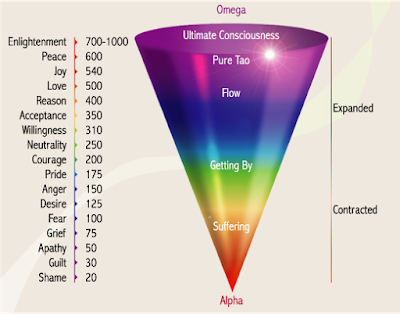
You may have seen this scale many times, it's from the book called Power vs. Force by David Hawkins, and it's the understanding that there are different levels of vibrational states of being. Here under these levels, you will find that at the bottom you have a tendency of shame such as guilt, and then ultimately you shift into wiliness neutrality. Above that you are closer to love and acceptance, then love and joy and peace all the way up to enlightenment.
3-4 years ago, before I began transmuting and really started studying all this knowledge, I was still engrossed in the lowest emotional state of being (I'm not claiming I'm perfect or enlightened now; I'm still exploring).
Mostly, I felt guilt; I felt anger from my childhood and some of the stuff I've been through. I had attachments to experiences that just didn't serve me. But when I start to transmute, something happened to me. I became really mindful of my thoughts.
Our thoughts are still going to come from a specific angle, and there's going to be a certain momentum in our thoughts. I've had a number of feelings that have been in motion and a constant loop of feeling anger over certain stuff, that feeling of shame or guilt about things I wish could let go but unable to do anything about it.
But as soon as I started to practice transmutation techniques, I started to observe my thoughts. And this difference between observing thoughts was the game changer for me!
The first step towards transmutation for Spiritual Awakening:
Transmutation is a technique of transferring energy from the lower Chakras of the body to the higher Chakras. If you're new to Chakras, I'll come to that in a moment, but for now, let's look at the transmutation.
For something like a spiritual awakening, you’re going to require a lot of energy that can be transmuted! And trust me, you literally don’t have worry about it. There’s a built-in energy station in your body that can produce more than enough energy for you to achieve spiritual awakening.
Sex. It is the guiding force of existence, the energetic core of existence. The essence of worldly life is Liberation (Moksha) and the essence of the body is semen (Virya). All objects in the universe by nature are diminishing. Semen is the only one that can rise (Urdhvagami) if you choose to. Thus, the seed of intent (causes) for the energies of the semen is the rise towards spirituality.
Let's just say that there is certainly a valid explanation that all spiritual traditions recommend ‘Celibacy.’ Sex is amazing, but no sexual experience could even come close to this.
From the pollination of plants to the innate desire to reproduce in animals and humans alike, nearly all has a sex drive—and the sex drive is the result of our libido.
At the source of all existence, sex is the cornerstone of all life; from the birth of an infant to the ecstatic conception of a piece of art, all growth is rooted in libido.
If you have an unwieldy sex drive or just want to harness this energy in for your spiritual growth, keep reading. You might be amazed at what the power of your libido can do!
What is Sexual Transmutation?
 Sexual transmutation is the alchemical process of channeling and guiding the sexual energies to a higher purpose of life. As one of the most strong forces of creation, our sexual energy may be guided toward achieving ambitions, manifesting desires, and reaching deeper states of consciousness.
Sexual transmutation is the alchemical process of channeling and guiding the sexual energies to a higher purpose of life. As one of the most strong forces of creation, our sexual energy may be guided toward achieving ambitions, manifesting desires, and reaching deeper states of consciousness.Your sexual energy is incredibly precious, and it is much more precious if you want to achieve spiritual growth. Brahmacharya is a term within Indian traditions that simply means "conduct consistent with Brahman" or "on the path of Brahman." Yoga, Hinduism, and Buddhism usually apply to a lifestyle marked by sexual continence or abstinence. (In western culture, it is referred as ‘Celibacy’).
Throughout the Hindu, Jain, and Buddhist monastic practices, Brahmacharya means, among other aspects, a mandatory renunciation of sex and marriage. This is considered important for the spiritual growth of a monk. Western notions of religious life as practiced in monastic settings reflect these characteristics.
According to Ayurveda, Semen is the last Dhatu to be formed out of Majja or Marrow. From food chyle (Rasa) is manufactured. Out of chyle comes blood (Rakta); out of blood comes flesh; out of flesh comes fat: out of fat comes marrow; out of marrow comes semen. These are the seven Dhatus. From start to finish, it takes the male body an average of 74 days to produce new sperm cells. There are three divisions in each Dhatu. Semen nourishes the physical body, heart, and intellect.
The ignorant man is a tool in the hands of his Samskaras and Karmas. Slowly he gains strength by understanding his true essential nature, by doing spiritual Sadhana, and by removing desires and greed.
If sexual energy is transmuted into Ojas, the shiny essence (Tejas) of all seven Dhatus is Ojas. It is the strongest aspect of the seven Dhatus gathered together) or the spiritual energy of pure consciousness, called sex-sublimation in Western Psychology. Just like metals and chemicals are dissolved by heating, similarly sexual energy is purified and converted into spiritual energy through spiritual Sadhana, through enjoying pure soul-raising thoughts of the Self or Atman.
In Yoga, one is called the Ordhvareta in whom the seminal energy has flowed upward into the brain as Ojas Shakti. There is no possibility of the semen going down through sexual excitement.
Brahmacharya/Celibacy is a very difficult practice. It demands constant and long-lasting Sadhana and perfect discipline. The Yogi who has mastered complete sublimation has complete power over lust. There's no possibility of his destruction. He's absolutely free!
He can embrace young women, yet he will be completely free from impurity. This is a really high point! Thus just a small amount of people can attain this sublime exalted state. Sri Sankara, Sri Dattatreya, and Jnana Dev of Alandi had reached this stage.
The procedure of sex-sublimation is rather complicated, but that it is most important for the aspirant to pursue the path of spirituality. It is the most significant qualification for the aspirant who is looking for supreme bliss and enlightenment. You've got to achieve this at any cost.
Brahmacharya is a simple pre-requisite for an aspirant. If one has this qualification or quality, any other qualifications would be linked to him; all spiritual qualities will come automatically to him.
All in all, the supreme aim of human life—spiritual attainment—requires the greatest accessible Pranic resources at all levels: mental, intellectual, and emotional. It's via Prana that one has to regulate one's senses. This is via Prana that one always has to have the restless nature of the mind. This is by Prana that one needs to centralize all the dispersed rays of the mind to make it one-pointed in focus. It is through Prana that one has to direct the concentrated mind to the object of meditation.
If you get engaged in a sexual impulse, the stock of sexual energy from inside will drain, decrease and go down. It's going to accumulate there and then discharge quickly. But if the thought, which emerged as a consequence of the sexual impulse, is uprooted and tossed away as soon as it arrives, then the sexual force will not be drained and thus will not go down. It'll rise to a higher level in the spiritual world. There's a huge science going within.
or reload the browserDisable in this text fieldEditEdit in GingerEdit in Ginger×Enable GingerCannot connect to Ginger Check your internet connection
or reload the browserDisable in this text fieldEditEdit in GingerEdit in Ginger×
October 20, 2020
Yoga For Beginners: Hatha Yoga: Everything You Need to Know!!
Are you looking for a gentle, mindful yoga practice? Do you want to enhance mental tranquility, physical health, and divine influence? Do you want to fill your life with strength, courage, flexibility, peace, opulence, balance, and perfection? Are you looking to balance, harmonize, and unite the two fundamental energies in your system, your solar and the lunar energies? If so, Hatha Yoga is what you need.
Hatha is a general category that includes most styles of yoga. It is an old system that includes the practice of Asanas (yoga postures) and Pranayamas (breathing techniques), which help bring peace to mind and body and prepares the body for deeper spiritual practices such as meditation. It emphasizes the cultivation of the body as a way of attaining a state of spiritual purity in which the mind is removed from external objects.
In India, Hatha Yoga in popular tradition is associated with the Yogis of Natha Sampradaya through its traditional founder, Matsyendranath. Almost all hathayogic texts belong to the Nath Siddhas, and the important ones are attributed to the disciples of Matsyendranath, Gorakhnath or Gorakshanath.
Hatha Yoga, once considered to be the mother of all other forms, is now seen in the West as their sibling. All the forms of yoga that you know—Iyengar, Ashtanga, Vinyasa, Kundalini, Power, Sivananda, Yin, Viniyoga, Restorative, Moksha, Kripalu, Forrest, Jivamukti, Anusara, and Bikram—come from what was once a full-life path and moral code called Hatha Yoga. But in today’s world, Hatha Yoga is just another form of yoga.
Hatha Yoga is a preparatory process of yoga. The word "Ha" means the sun, the word "Ta" means the moon. "Hatha" means a yoga that brings the equilibrium between the sun and the moon within you, or Pingala and Ida within you. You can pursue Hatha Yoga in ways that carry you beyond certain limits, but essentially, it's a physical preparation—preparing the body for a higher possibility.
Hatha Yoga has become a popular form of exercise in many parts of the world. Its easy accessibility and emphasis on health and well-being have made it play an important role in counteracting the many harmful impacts of a rapidly changing world.
Hatha Yoga has grown in popularity in the West as an exercise that improves strength,endurance, relaxation, and focus of mind. It offers an opportunity to stretch, unwind, and reduce stress, offering a strong counterpoint to both busy lives and aerobic exercises. As with any other yoga practice, it can be done by anyone, regardless of sexuality, race, class, or creed.
Training involves breath, body, and mind, and sessions typically require 45-90 minutes of breathing, yoga poses, and meditation.
A typical Hatha Yoga class comprises the following parts:
1. Pranayamas
2. Sun Salutations
3. Asanas
4. Savasana
5. Meditation
Pranayama: Pranayama translates to 'extension of life force.' ‘Prana’ means life energy or breath, and ‘Ayama’ means to extend. Pranayama practice prolongs the life within us and awakens our Kundalini energy.
Pranayama comprises controlled breathing techniques that have a direct impact on your nervous system and the energy of your body's life force. You would be introduced to deep breathing techniques and possibly some breathing exercises to stimulate or relax your mind and body, depending on the nature or time of the class.
Sun Salutation: Several Hatha classes use Sun Salutations to warm up the body and build up heat within. Sun Salutation is a flow of yoga asanas linked with breathing. They are incredibly energizing, and integrating the inhalation and exhalation with each transition generates a moving meditation, promoting stillness and concentration in the mind.
Asanas: You'll be guided by standing postures, core work, balancing postures, backbends, inversions, and floor poses. The layout of the session is organized in a standardized manner to make it easier for you to get the best out of each pose. Poses vary in complexity from lying flat on the floor to physically demanding positions.
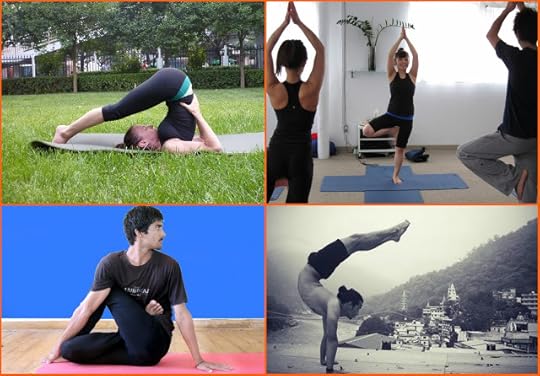
Savasana: Or Corpse Pose, is everyone’s favorite. This final pose requires you to lie on your back with your arms and legs apart, like a starfish, and to let go fully.
Savasana is an important part of the yoga class which gives the body and mind time to rejuvenate and absorb all the positive work you have done with your body.
You will usually lie here for 5-10 minutes, with your eyes closed and your body heavy on the floor. Breathing deeply in Savasana helps you to relieve stress in your body and to wake up feeling energized and nourished.
Being mindful of your breath makes it easier for your mind to stay in the current moment and to help create the framework for sitting meditation.
Meditation: The bulk of Hatha Yoga classes conclude with a brief duration of meditation. During this time of peaceful relaxation, you sit in Sukhasana or Lotus Pose and enjoy a relaxing meditation.
The standard Hatha Yoga class ends with participants putting their hands together in a praying posture over their hearts, bowing and saying Namaste to each other and thanking God.
2. Helps develop Discipline and Self-Control
3. Prepares the Body for Meditation
4. Enhances Core Strength
5. Hatha Yoga lets You have a Better Night's Sleep
6. Decreases Anxiety and Stress
7. Results in Healthy Glowing Skin
8. Improves Joint Flexibility and Mobility
9. It Enhances the Quality of Prana
10. It Promotes Balance and Improves the Posture
11. Relaxes the Mind and Releases the Stress in the Body
12. You develop an Optimistic Attitude
13. Helps with Weight Loss
14. Results in a Calmer and Happier Mind
15. Helps in Kundalini Awakening
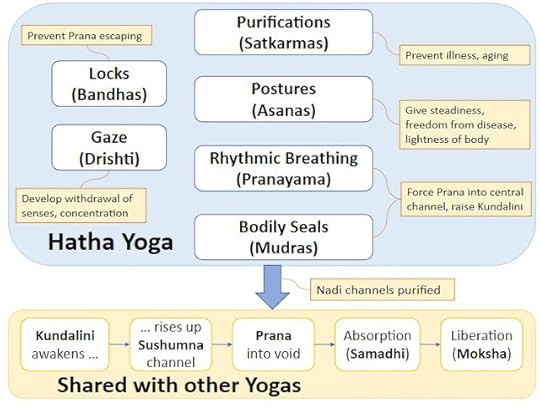
16. It Harmonizes Body-Mind
17. Promotes Mindfulness and Spiritual Growth
Some Beginners Tips1. Always practice after taking a shower and empty your bladder and bowels.
2. Never practice on a full stomach.
3. Always listen to your body. The beauty of yoga is that if anything doesn't feel right, it's fine to get out of it. There's no "no pain, no gain" attitude here. It's OK not to go to the full expression of the pose, because where you are, as long as you have the correct posture, it's beneficial. What you want to do is go to the "edge"—where you experience sensation, but not pain.
4. Do not eat the food right after yoga. There should be a gap of at least 20-30 minutes between the practice and the meal.
5. You must not hold your breath until you are clearly instructed to do so. And always breathe from the nostrils unless otherwise instructed.
6. If you're in a class, don't compare your practice with that of another student, or even a coach. Or also your own (because your body varies day-to-day-sometimes in the same pose from one side to the other). Focus on your practice, your breath, on what the teacher tells you. Competition can rid you of the enjoyment of your practice and will make you attempt positions that your body is not ready for.
7. Those just starting Hatha Yoga practices often report exhaustion and soreness in the body, as yoga stretches and exercises muscles and tendons that are sometimes long-neglected. Some yogic breathing and mediation methods can be challenging for beginners and can induce dizziness or disorientation. Whenever this occurs, just relax and keep going as per your will. Overtime, exhaustion and soreness will be gone and you will be able to perform the various practices seamlessly. 8. If you feel weak during asanas, drink a small amount of honey in lukewarm water.
To learn more about Hatha Yoga, consider reading my book, Yoga For Beginners: Hatha Yoga

This Hatha yoga guide is perfect for beginners and those of you looking for a more mindful practice. It will strengthen and stretch the body, keeping each pose for several breaths. Hatha yoga appears to be gentler and slower than a Vinyasa or Power style class. If you’re new to yoga, recovering from injury, or looking to relax by moving gently and thoughtfully, this yoga form might be the best fit for you.
All you’ve got to do is show up. When you decide to take care of yourself, all kinds of good things begin to happen. You’ll have more energy. You’ll become relaxed. Your attitude to life will turn more optimistic.
Hatha yoga rituals, including asana, pranayama, mudras, and mantras, cultivate strong energies to promote improvement both mentally and physically. They will change the way you feel in your soul and body.
In this guide, you’ll discover:
✔️Science Behind Hatha Yoga
✔️Who Can Perform It
✔️Benefits
✔️Things You Need to Know Before Starting
✔️Hatha Yoga Mantras, Mudras, Pranayamas, and Asanas
✔️Hatha Yoga Meditation
✔️Beginner’s Common Mistakes and How to Fix Them
✔️Common Myths and FAQs
So, are you interested in learning all about how Hatha Yoga can benefit you? This is a comprehensive guide to take a closer look at what this gentle and slow-paced yoga style can do for you and how you can master it for your overall well-being.
Covering the fundamentals of each practice in depth, and how to correct the most common errors, this Hatha Yoga Guide has left nothing to help you attain mental, spiritual, and physical well-being.
Now don’t bother, claim your copy right away!!

or reload the browserDisable in this text fieldEditEdit in GingerEdit in Ginger×
October 16, 2020
Ayurveda For Beginners: Kapha
Ayurveda, which derives from ancient Vedic scriptures, is a 5,000 year-old medical ideology and philosophy based on the idea that we are all made up of different types of energy.
There are three Doshas in Ayurveda that describe the dominant state of mind/body: Vata, Pitta, and Kapha. While all three are present in everyone, Ayurveda suggests that we each have a dominant Dosha that is unwavering from birth, and ideally an equal (though often fluctuating) balance between the other two. If Doshas are balanced, we are healthy; when they are unbalanced, we develop a disorder commonly expressed by skin problems, impaired nutrition, insomnia, irritability, and anxiety.
Vata, Pitta, and Kapha are all important to our biology in some way, so no one is greater than, or superior to, any other. Each has a very specific set of basic functions to perform in the body.
That said, when the Doshas are out of control, our wellbeing can be damaged. However, before we get into the particulars of each of the three Doshas, it is helpful to understand their basic nature and their wider function in the natural world.
Throughout Ayurveda, the most basic building blocks in the material world are the five elements: space, air, fire, water, and earth.
Vata is characterized by the mobile nature of Air (Wind) energy.
Pitta embodies the transformative nature of Fire energy.
And Kapha reflects the binding nature of Water energy.
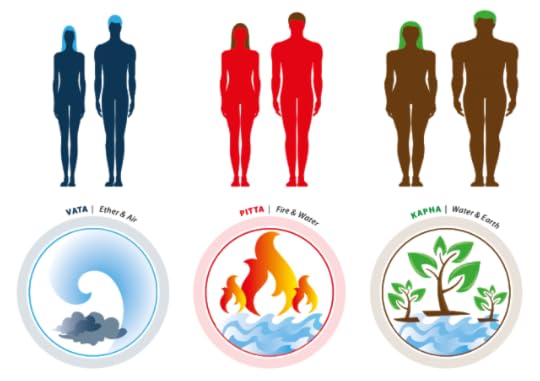
The elements of the earth and water combine with the Kapha. Kapha then unites properties such as heavy, slow, and steady, but also soft, thick, hard, and cold. In the body, Kapha is liable for solidity and all structures as well as for the right volume of body fluids.
Kapha controls both the structure and lubrication in the mind and body. It regulates the weight, growth, lubrication of the joints and lungs, and the creation of all seven tissues—nutrient fluids, blood, at, muscles, bones, marrow, and reproductive tissue. Protection is the primary feature of Kapha.
They're calm, rooted, and genuine while Kaphas are in harmony. If Kaphas get out of control, they binge-eat and under-exercise, triggering weight gain and diabetes.
What's The Meaning of Kapha?

Kapha stems from the elements of Earth and Water and translates as "that which sticks." It is the strength of building and lubrication that gives the body the physical form, structure, and smooth functioning of all its parts. Kapha may be thought of as the body's essential cement, glue, and lubrication in one. The unofficial Kapha Dosha mascot is an elephant.
Just as a nourishing rainstorm can turn into a rampant flood, the body's fluids can flood the body's tissues, contributing to a heavy dampness that weighs down the body and clouds the mind.
Kapha is the energy that shapes the structure of the body—bones, muscles, tendons—which provides the "glue" that binds the cells together, made by earth and water. Kapha provides water to all parts and systems of the body. It lubricates the joints, moisturizes the skin, and maintains immunity. In balance, Kapha is expressed as compassion, quietness, and forgiveness. Out of balance, this leads to addiction, greed, and envy.
Kaphas are calm, rooted, and genuine while in harmony. If Kapha get out of control, they binge-eat and under-exercise, triggering weight gain and diabetes.
Kapha Dosha is the power of stability due to the rooted, stable elements that create it. Kapha types represent earth and water in its physical, mental, and emotional being. The body of Kapha types is strong and often stocky. It's really easy for Kapha types to add weight, and it's always hard for them to lose weight.
They have major features: dense hair, large eyes, and thick lips. The Kapha persona is sweet, caring, and faithful. They're the ones at the group or social event to make sure everybody else is all right. They're trying to make sure your drink is finished; you've eaten, you're not either too hot or cold. Kapha types are often strong, calm, and regular. The unofficial Kapha Dosha mascot is an elephant. They walk steadily, open their hearts, and have innate respect towards others.
Like Earth's stability, the Kapha personality holds peaceful, serene strength. A patient nature, love, and well-grounded beliefs are the distinguishing virtues that make the Kapha individual a faithful, true friend.
The complexion of the Kapha is pale, soft, and cool. Rich red and purple warm their cool skin, and garnets and rubies are the height of your strength and courage. The gentle manner of Kapha is charming, not to mention soothing and understanding. A quick massage with heated oil, some energetic music with a fast rhythm and a high volume, and Kapha would be up and moving again in no time.
According to Ayurveda, Kapha usually has a structure that is vulnerable to weight gain, sometimes even with a regular diet. Kapha skin is normally Oily, the hair appears to be dense and lustrous, but is susceptible to oiliness that needs to be controlled.
Symptoms of Kapha Dosha Imbalance:
Physical:
· • Mucoid diarrhea
• Pre-diabetes
• Fatty buildup in the arteries
• Hay fever
• Cold/cough/runny nose
• Excessive mucous
• Slow/sluggish bowel movements
• Impaired appetite
• Lack of energy
• Cold sweats
• Excessive urination
• Excess ear wax
Behavioral:
• Ignorance
• Greed
• Depression
• Stubbornness
• Emotional overeating
Ask these questions to see if you have to manage Kapha:
1. Do you sleep for a lot of hours, yet wake up unrefreshed?
2. Do you feel stiff and sluggish, particularly in the morning?
3. Do you experience congestion?
4. Are your skin and your hair oily?
5. Do you think you're possessive and over-attached?
6. Do you have a propensity to be overweight?
7. Do you have sinus problems?
8. Do you feel tired, complacent?
If you replied “YES” to any of these issues, you have to balance your Kapha Dosha.
1. Add Tastes That Favors (Prefer Pungent, Astringent, and Bitter tastes)
2. Restore and Maintain Balance
3. Stay Warm and Dry
4. Eat for Your Type
5. Seek Newness
6. Consume Herbs
Tastes That Pacify Kapha
Emphasize
Pungent
Many spices have a pungent taste and are Kapha pacifying due to their hot and dry properties. Pungent taste is a mixture of fire and air.
• Pungent is a hot, spicy taste present in chilies, radishes, turnips, raw onions, and most spices. In fact, most spices are incredibly pacifying—we'll see them in the list of Kapha-Pacifying Foods.
• The pungent taste is light, hot, rough, and dry—all great for Kapha. Essentially, if you like extremely hot or spicy dishes, go for it, and even if you don't, prefer a wide variety of milder spices in your dish—cardamom, cloves, cinnamon, cumin, ginger, garlic, paprika, and turmeric.
• The pungent taste cleans the mouth and clears the senses. This promotes digestion, liquefies secretions, cleanses the body's channels, induces sweating, and thins the blood.
Bitter
The bitter taste is cooling, rough, drying, light, and reducing to Kapha. This has all the attributes that help to pacify Kapha. This is usually missing in our diet regardless of its palatable taste.
It can hence also come in handy when there is an aggravation of Kapha due to excess Kapha generating food that induces indigestion.
Spices such as turmeric and fenugreek seeds and leaves will offer a bitter taste to our food whenever it is needed. Constitutionally, the bitter taste is a mixture of air and space.
• The bitter taste predominates in bitter greens (such as kale, dandelion greens, collard greens, etc.) and is also present in bitter melon, Jerusalem artichokes, burdock root, eggplant, dark chocolate, and Kapha-pacifying spices such as cumin, neem leaves, saffron, and turmeric.
• The bitter taste is rough, drying, light, and generally reducing—all the qualities that benefit Kapha, but it's also cooling, so it is important to add some warm spices to the bitter food.
• Bitters disinfect the pallet and enhance the sensation of taste. They tone the skin and muscles, enhance appetite, facilitate digestion, and help to absorb moisture, lymph, muscle fat, adipose tissue, and sweat.
Astringent
The astringent taste is dry, cold, and heavy in nature, but mildly pacifies Kapha due to its drying properties. Triphala, artichoke, and jack fruits are examples of an astringent taste. The astringent taste is a mixture of air and earth components.
• The astringent flavor is simply a dry flavor—a chalky taste that dries the mouth and can cause it to contract (picture biting into a very green banana).
• Legumes such as adzuki beans, black-eyed peas, chickpeas, kidney beans, lentils, pinto beans, and soybeans are classically astringent in taste and very Kapha-pacifying. Some fruits, vegetables, grains, baked products, and spices are often astringent in taste—such as apples, cranberries, pomegranates, artichokes, broccoli, cauliflower, lettuce, popcorn, rice cakes, crackers, basil, coriander, dill, fennel, parsley, and turmeric.
• The astringent taste is dry, rough, mildly light, and reduces the Kapha. But like the bitter taste, it's also cold, and it's best to add warm herbs and spices to astringent foods. For some cases (as in the case of pomegranate), eating such foods in the warmer season makes a lot of sense.
• Kapha gains from compressing, absorbing, and the essence of the astringent taste which often helps tone body tissues and utilizes excess fluid.
Minimize
Sweet
Sweet is soothing and calming which, in moderation, encourages longevity, strength, and stable body fluids and tissues. The thick, greasy, wet properties tend to slow down digestion.
It is also recommended in Ayurveda to consume dessert first as an appetizer when the digestive or metabolic fire is at its peak.
Sweet taste is present in foods including most fruit, most grains, root vegetables, milk, ghee, fresh yogurt, eggs, nuts, seeds, and most oils except mustard. The sweet taste is the most potent to aggravate Kapha owing to its cooling, grounding, nourishing, strength building, and satisfying properties.
Please note that when we talk about the sweet taste we talk about foods with a naturally sweet taste and/or a sweet post-digestive effect, for example, sweet potatoes, white rice, and wheat. Constitutionally, the sweet taste has the elements of Kapha, water, and earth, aggravating Kapha the most.
• The sweet taste is cold, heavy, moist, oily, and Kapha-provoking, particularly in excess.
• Reduce or eliminate the consumption of processed sugar and sugary sweet products as much as possible.
• It will be difficult to eat a healthy diet and resist that sweet taste. Yet it is definitely appropriate to reduce the amounts of naturally sweet foods such as fruit, grains, root vegetables, milk, ghee, yogurt, eggs, nuts, seeds, oils, and meats.
• Sweet foods tend to exacerbate the tendency of Kapha to heaviness, obesity, lethargy, and oversleep. They can also cause excessive mucus, aggravate colds and coughs, and suppress appetite in an unhealthful manner.
Sour
Sour taste activates the mind and senses, triggers digestive juices, enhances digestion, and reduces excess wind.
If taken in abundance, it aggravates Kapha. Lemon juice, tamarind, sauerkraut, apple cider vinegar, and sour-sweet fruits such as orange, pineapple, and kiwi are a few examples. It has a mild Kapha aggravating impact due to its constitutional elements of fire (provokes Kapha) and earth (supports Kapha).
• Minimize sour foods such as vinegar, cheese, sour cream, green grapes, oranges, pineapple, and grapefruit.
• The moisturizing and oily properties of the sour taste make the Kapha worse.
• A sour taste can increase thirst, cause heaviness in the eyes, cause laxity in the body, and increase water retention or swelling.
• An occasional lemon juice or lime juice is the best way to consume the sour taste for Kaphas.
Salty
The salty taste increases hunger and digestion. This helps retain moisture and facilitates effective elimination. This also enhances the taste of other foods.
Salt in its different kinds—sea salt, rock salt, and common table salt is the main source of the salty taste. It is intended to be used in very small quantities. It is made up of fire and water and may thus exacerbate Kapha mildly.
• The salty taste is perhaps entirely derived from the salt itself.
• Like the sour taste, the moist and oily nature of salt is what causes Kapha aggravation.
• Excessive salty taste can induce water retention, high blood pressure, inflammation of the bowel, grey hair, wrinkles, excess thirst, and can interfere with the sense organs. Moreover, it tends to stimulate a strong desire for more flavors, and it may also cause insatiability and greed.
Extra Precautions:
1. Don't work or talk on the phone while you're eating.
2. Don't read or watch TV.
3. Offer thanks or sit down in silence for a minute before you start eating.
4. Do not chew down the food; savor every bite and chew properly before swallowing.
5. A few sips of warm water during the meal will aid digestion, but do not consume too much of any drink.
6. At any meal, do not eat until you are very full. The perfect Ayurvedic portion is what you could hold with your both palms joined together. Leaving a space in your stomach after you're finished supports digestion.
7. Once you've finished feeding, sit still for a couple of minutes; don't try to perform the next task of the day instantly.
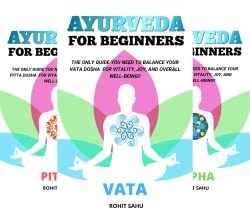
Enable GingerCannot connect to Ginger Check your internet connection
or reload the browserDisable in this text fieldEditEdit in GingerEdit in Ginger×Enable GingerCannot connect to Ginger Check your internet connection
or reload the browserDisable in this text fieldEditEdit in GingerEdit in Ginger×Enable GingerCannot connect to Ginger Check your internet connection
or reload the browserDisable in this text fieldEditEdit in GingerEdit in Ginger×










